If you would like a printed copy of any of our back issues, then they can be purchased on Farm Marketplace. You can also download the PDFs or read online from links below.
-
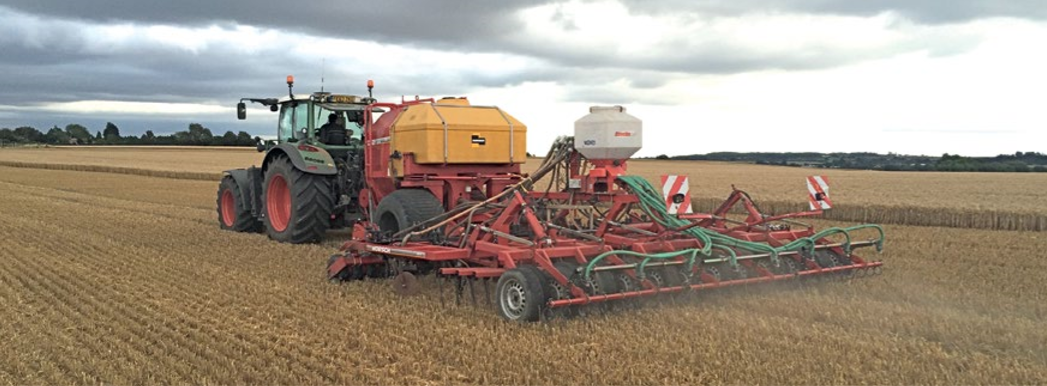
How To Start Drilling For £8K
Clive Bailye’s seed drill of choice is his 6m John Deere 750A , which has been used exclusively for 3-4 seasons. Last year, with an increased acreage, the founder and publisher of this Direct Driller magazine thought a second seed drill was necessary. Having just the one machine was a risk and in a difficult season would mean drilling was delayed. He looked around and found a good condition Horsch CO6 tine drill advertised in Germany.
Words and pictures by Mike Donovan
After delivery he rebuilt the coulters to a narrow profile so as to reduce soil disturbance. He says the tine drill is very useful driling after straw crops such as osr and also through the straw on second crop cereals.
Buying the drill from a German farmer was not particularly complicated, and provided him with a higher spec machine than Horsh sell in the UK. The seed dart tyres are much wider, and the machine is fitted with blockage monitors as well as full width front packers and also a liquid fert application system.
A sheaf of photos were taken, and Clive then asked for some of specific parts to show wear. The deal was done at under £5,000 which Clive says is the market value of these machines which are too large for small farmers to buy. Original owners like to buy new and sell when the machine is still in good condition.
Narrow tines with wear tiles
@Clive knew he wanted to make changes, substituting the Horsch tines and coulters for something far narrower, and has ended up getting his own design of tine made, which has a wear tile made from Ferobide, far harder than tungsten. The drill is on the farm primarily for osr and 2nd crop cereals drilled into chopped straw and the 25cm spacing is okay for these crops.
Comments on Clive’s on-line forum, TFF, said the drill many not be so good with beans, as the slot is a mere 12mm wide. And in barley the spacing may well be too wide as it needs to be thick. Clive points out that the seed pipe can actually be a bit wider than 12mm as it is in the shadow of the point. It would be good to have the option of using it for beans.

Above left: The cheap CO6 is being calibrated ready for its first outing

Above right: The adapted Horsch is being filled by the home built drill logistics trailer with seed and liquid starter fert.
Getting around the German instructions
The Horsch came, of course, with a control box and instructions in German. More on-line discussion revealed that English instructions were available on the Horsch website, and another explained that Horsch was sourcing some of these parts from Agton in Canada anyway. Zealman from New Zealand explained that the button marked with callipers should be held down for around 5 seconds. The menu is where you adjust the tramline sequence, valve layout and row numbers.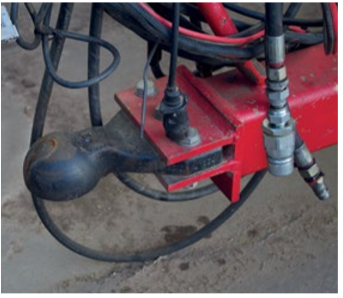
Ball hitch is a continental standard and provides a positive connection between tractor and drill

The Stocks Wizard has a rotor modified for Avadex which otherwise leaks everywhere
A Stocks Wizard is on the back of the drill and used for Avadex. Here again the knowledge of actual farmers is helpful. Alistair Nelson warned that the rotor and the surrounding shroud need to be changed, and he got good advice “from Rick at Stocks”. Clive has the same setup on the 750A and says that the Avadex leaks everywhere unless the modification is made. The drill was acquired and modified in 2016 and the results have been excellent.
The machine went through the residue without many problems and having the second drill has meant more timely planting. Clive has shown that moving into No-Till is not the expensive exercise so many farmers think it might be. The total cost, after modifications which included replacing all tines and coulters, was under £8,000.
Author Mike Donovan writes: we have featured a number of home made direct drills in @Practical Farm Ideas, and are always interested in seeing more. Please contact mike editor@farmideas.co.uk or 07778877514.
-

Drill Manufacturers In Focus…
AMAZONE – THE PEDIGREE IS THERE WHEN IT COMES TO MINIMUM DISTURBANCE DRILLING

When it comes to what’s currently trending in crop establishment, the focus is very much on plant nutrition and the targeted application of N & P fertilisers along with the seed to bolster root development and to enable the plant to grow away strongly from pests and diseases. Multi-hopper seeders now offer that flexibility of being able to combine different seed types, add a starter fertiliser or the addition of slug pellets or a micro-granular herbicide simultaneously with the drilling operation. Seeding depth can be split into different zones as well by the addition of a second or third material entry point.

In the area of reduced tillage drilling, three drills stand out strongly in the AMAZONE range, all featuring that multi-hopper format: the Condor direct tine seeder, the Cayena tine seeder and also the Primera DMC. Since the late 1970’s, AMAZONE have pursued their chisel opener philosophy when it comes to reduced tillage seeding systems. After numerous field trials in those early years, Dr. Heinz Dreyer, father of current joint owner of the AMAZONE Group, hit upon his successful formula of running a hard-faced chisel opener to place the seed in the ground rather than using a disc. This avoided crop residues being hairpinned into the seed slot and generated a slight tilth which improved seed/soil contact as well as mineralising some nitrogen in the seed zone to improve plant development. The principle of the NT chisel opener continues today in those Condor, Cayena and Primera drills.
The Con-dor, with three stagger of coulters and a row spacing of 25 cm or 33 cm, makes it ideal for inter-row mechan-ical weed control and comes in working widths of 12.0 and 15.0 m. The Cayena, again with three stagger of coulters, a covering harrow followed by a targeted reconsolidation, is widely renowned for its low horsepower requirement and ability to run in many conditions, is in 6.0 m only whereas the Primera DMC is available in either 3.0 m or 6.0 m widths.
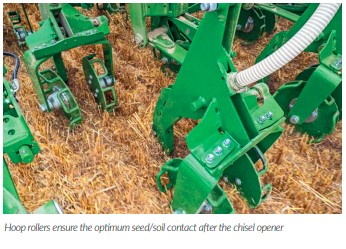
Featuring at Groundswell this year will be the Primera DMC 6000-2C The Primera 6000-2 DMC is more than just a direct drill as does what it says in the name, DMC – direct, mulch, conventional. Huge underbeam clearances, and the openers in banks of four rows, mean that copi-ous amounts of straw and cover crop can pass through the drill without any fear of blockage. Each chisel opener closely follows the ground contours via a parallel linkage – guided by individual hoop rollers behind the coulter with the depth set mechanically on a spindle. The narrowness of the chisel opener means that little soil is disturbed but the seed slot is left clean for good seed / soil contact and the micro-tilth generated by the chisel action can then be pushed back into the groove by the angled hoop rollers following. On the rear, a choice of either the Roller harrow, for light dry conditions or in the spring where moisture conservation is cru-cial, or the wellknown universal Exact harrow, is used to finish off the seedbed profile.
The 4,200 litre split hopper, carried on flotation 700/45 -22.5 tyres with its twin electrically-driven metering systems, can feed both seed and fertiliser down to the coulter. The Primera 6000-2C weighs in at just 6,500 kgs and pulling power is a modest 180 hp for the 6m drill and, due to the little amount of soil-engaging parts and the robust-ness of the construction, the drill suffers from little wear and tear.
New for 2022 is the option of the GreenDrill 501 catch crop seeder box which now can be added to make a third hopper. The GreenDrill can be specified to broadcast seed on the soil surface ahead of the Roller har-row or can apply a third material down the sowing coulter. The electrically-driven metering system is com-bined with the other two hoppers and is controlled via the ISOBUS software and can be run off a third VRA application map. On the headlands the three hoppers can switch off at different times using the unique Multi-boom software.
-

Drill Manufacturers In Focus…
INDIVIDUAL PLANT DETECTION – CAMERA SYSTEMS WITH A FUTURE?

Camera-based plant protection – the technology already exists but where do we stand when it comes to using it in practice? HORSCH LEEB has been carrying out tests in this respect for quite some time. Theo Leeb tells us about the challenges and the chances.
What is the state of technology with regard to individual plant detection?
‘Theodor Leeb: At the Agritechnica 2019, some startup companies already presented camera systems for spot spraying weeds. This made the expectations of customers, manufacturers and also of political decision-makers rise.

In the past few years, we tried to shed light on this topic and to test where we actually stand. To begin with, spot spraying with optical sensors or cameras is not basically new. This method has already been used for about 20 years in the typical no-till regions with low rainfall like Australia, Russia or Kazakhstan – namely in the “Green on Brown” sector. Another method is “Green in Green”. So the technology already exists. The question is which system really makes sense when and where.
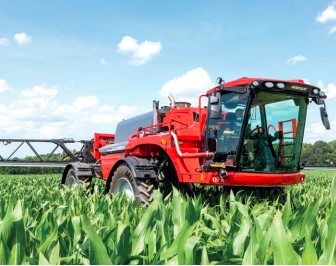
What does “Green on Brown” and “Green in Green” mean?
Theodor Leeb: There are two principles: “Green on Brown” and “Green in Green”. Brown corresponds to the arable soil and green to the plant – whether cultivated plant or weed. The topic Green on Brown has been existing for quite some time. Among others, some manufacturers offer systems for the application of glyphosate before sowing. This method is mainly used in no-till regions. With the Green in Green method, you have to differentiate between cultivated plant and weed. And partly you also get the information what kind of weed it is. With regard to the question how far we have come with this topic: We carried out some tests this season and also last year. With regard to Green in Green we for example tried to spray thistles in wheat. Thistles normally appear in nests and not on the whole field. This would be a typical application for spot spraying. With the test, we wanted to find out how exactly the system detects the thistles and what hit rate we would achieve. We basically can only say that the system works. The thistles were detected but only partly. The hit rate ranged between 40 and 60 %. The question, of course, is if this is enough. In my opinion, it still is far from being field-ready. Moreover, as a farmer you wonder about the weeds that still are on the field – are they tolerable or not? This, of course, also depends on the kind of weed, but it should be clarified.
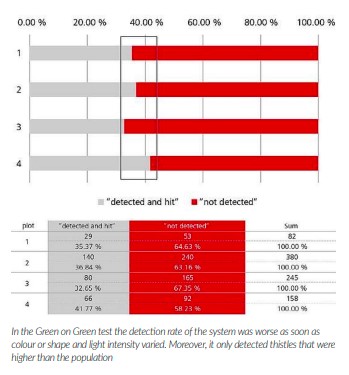
Were the thistles not detected or did the system not react fast enough and the thistles,
thus, were not hit?Theodor Leeb: In the test, we differentiated between “detected but not hit” or simply “not detected” and ogically not hit. But this also is a question of the calibration of the system. AT a 36-metre boom there are a total of 12 cameras which are mounted every three metres facing forward with a slanting angle. And the nozzles are assigned to each camera according to the spatial arrangement. It is a rather complex procedure to calibrate the individual camera positions to make sure that the appropriate nozzle opens at exactly the right time.
But the real problem rather is that the thistles indeed are not detected by the system. The biggest challenge are the different lighting conditions. I.e. there is a difference if it is cloudy or sunny, if you have to work with or against the sun etc. And the weather conditions in turn influence the shape of the thistle. The leaves for example roll up a little bit in case of a high solar radiation resulting in a significantly lower detection rate. So what we found out was that there still is need for optimisation.
How could the system Green in Green be improved to make it work?
Theodor Leeb: You have to know that there is an AI behind it. An incredible amount of training data is required to make sure that the system always detects the thistle. You need photos and data from thistles in all shapes, in all lighting conditions, growing stages, from all different thistle varieties etc. We are talking about thousands of photos that have to be analysed and labelled manually. Every pixel has to be assigned correctly. This is an enormous manual effort and finally the crux of the matter. The more labelled photos there are, the more exactly and reliably the system will work.
And a thistle is rather easy to detect compared to other plants.
Theodor Leeb: Exactly. The human eye can detect it rather easily and a human can also differentiate it. The difference between monocotyledonous and dicotyledonous plants is quite obvious. But if you want to differentiate for example black-grass from wheat it is getting difficult. This is where we possibly reach the limits of what is feasible.
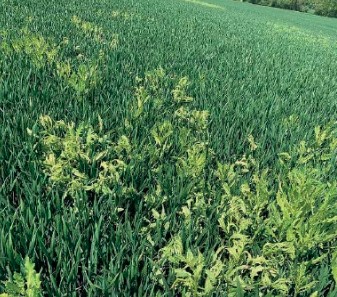
But there are further technical restrictions. An important point is the spot size, i.e. the smallest possible area that can be sprayed. In theory, the biggest savings potential would be if we treated every little weed with an effective spraying area of for example 5×5 cm. However, as we work with sprayers where the nozzles are mounted with a spacing of 50 cm or 25 cm, there is minimum spot width of approx. 60 cm respectively 35 cm depending on the nozzle layout. As the nozzles cannot switch infinitely fast, the spots in the direction of travel are about 50 cm long. If the distance between the weeds is smaller than 50 cm, the system will not turn off. Thus, for the savings potential the ratio of spot size and weed infestation is essential.
Physics respectively optics are two other limiting factors. Let’s take beets as an example: It is important to detect weeds at an early stage, i.e. when the size is one centimetre or even smaller. In theory, it is possible the detect this tiny plant with the system if you drive very slowly and can really look at it from all sides. But in practice, operational speeds of 10 km/h and more are common. To achieve a sufficient reaction time, the cameras face forward at a slanting angle. But if there is a large clod in front of the small weed or if another bigger plant hides the weed, the camera will not be able to detect it. So you cannot achieve a hit rate of 100 %. Now the question is what is acceptable. Are 90 % enough? At the moment, we simply do not know.
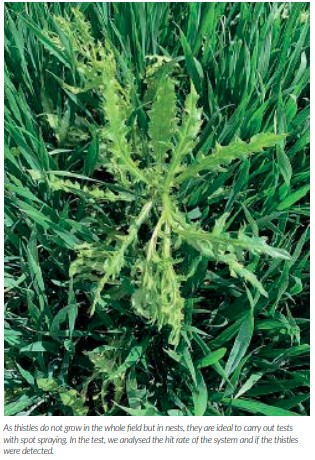
As thistles do not grow in the whole field but in nests, they are ideal to carry out tests with spot spraying. In the test, we analysed the hit rate of the system and if the thistles were detected.
So at the moment the topic is limited by the training data and physics.
Theodor Leeb: Yes, but there is another exciting question we have to clarify. In many row crops it is good professional practice to apply a soil herbicide after sowing. This guarantees a basic protection for a certain time. The weeds that emerge after two to three weeks then are treated with foliaceous agents. If you decide to do without the soil herbicide you logically have to wait until the weed has grown so that a camera can detect it. Let’s assume that we use the spot spraying method to apply a foliaceous agent on the emerged weeds: The problem is that the foliaceous agents affect the development of the cultivated plant. You cannot avoid spraying on it if the weed for example is close to the beet. Moreover, new weeds are constantly emerging all along. So the question is: How often do we have to spot a certain area to make sure that for example a beet field remains clean? We have not yet tried to do without the soil herbicide. But in my opinion, for beets, it does not make sense to do without it.
A reasonable solution would be a combination, i.e. a soil herbicide as the first measure and the other treatments with camera-based spot spraying systems. Another rather exciting idea is to accept a certain economic threshold respectively to tolerate certain weeds that are classified by the camera as they do not pose a problem in the next season due to a cleverly chosen rotation or because they are easy to treat. I think this might provide the biggest savings potential. However, it still requires a lot of development as the weeds do not only have to be detected but also have to be classified.
You have just been talking about herbicides. Can you image other sectors where this
method could be used?Theodor Leeb: In case of plant illnesses for example you could apply fungicides or even growth regulators in cereals in a site-specific way. However, this does not require such a finely itemised spot spraying system as in this case we are talking about a larger area. For this application we use our pulse system PrecisionSpray with a variable application rate per 3 metre boom section. But there are approaches to use the cameras to detect illnesses. The question rather is if it is not too late at that time. In my opinion, the approach via biomass and weather models would be more productive.
How does “Green in Brown” work?
Theodor Leeb: Together with a manufacturer from France we carried out tests. The method is based on a mere differentiation of colours, i.e. you have a camera image and analyse which pixels are green or brown, thus plant or field. The green areas are sprayed. This worked quite well, however this system is not of major importance in Central Europe as we usually carry out tillage and as the conditions are wet.
Could you explain this in more detail?
Theodor Leeb: On the high-yield sites stubble cultivation is usually carried out after the harvest to mix in the straw. After a few days or weeks volunteer crops and weeds emerge. I.e. the field more or less is green all-over. Spotting does not make sense as the plants are too close to each other. So you would have to treat the whole area and could not rely on point application. In dry regions where no-till farming is very common this is different. There is no tillage after the harvest. As it is very dry there are little weeds or catch crops. And in this case, you can – instead of spraying all over – work with a camera system in a targeted way for example to save costs when using glyphosate for spraying the individual plants.
In addition to Green on Brown and Green in Green there is another differentiation: offline and online methods. What I have described so far are online methods, i.e. the camera is mounted on the boom and while driving the system decides whether to spray or not. With offline methods you get the information by means of a previous scanning. You normally fly over the field with a drone that is equipped with a high-resolution camera and scan the field from a height of approx. 20 m. At the moment, an algorithm is used to differentiate weed from crop in the high-resolution photo. This system provides an application map with the sections that are to be sprayed. This information then is loaded into the terminal of the machine and the field is treated. It works similar to the application maps for fertilisation.
Together with a start-up company we also have made tests with offline system for quite some time. The system basically works, but there also are a few obstacles. For example if you want to spray you have to have current data. There is little point in flying over the field with the drone 14 days in advance as in the meantime the weed infestation will change. The other obstacle is a physical one. Because of the offset method the spots have to be larger to hit the weeds as the GPS tolerances of the drone and the sprayers add up. Larger spots in turn mean that the sprayed area is larger, too, and thus there is less savings potential.
The extremely high data volume is an additional challenge. Endless gigabytes per hectare are generated that are sent to a server for calculation. This often takes the current internet connections to their limits. On the other hand, the application maps have to be sent back to the terminal of the farmer. Depending on the number of polygons (spots) the current ISOBUS terminals only allow for applications maps with a size of less than 5 hectares.
This means: From a technical or technological point of view the offline method can be displayed. For practical use, however, some more time is required to optimise the processes. And first of all, we need solutions for the high data volume. We possibly even have to find a parallel solution to ISOBUS.
What is your summary?
Theodor Leeb: In my opinion, spot spraying is the next logical step to meet the future requirements with regard to Green Deal, environmental protection and sustainability. Consequently, we come from an all-over treatment over band application to small-area spot spraying. The objective always is to apply the agent only where it is really required. In this respect, a camera-based system – whether online or offline – can make a valuable contribution.
We are intensely working on an optimisation of these systems and we will continue to carry out tests to gather more experiences. Our task is to transfer everything that is possible from a technological point of view into practice in such a way that the farmer can safely and simply use these methods in his everyday working like. Thus, spot spraying can become another component with regard to the optimisation of conventional crop care. But I also see the limits of what is possible as in the field we do not have standard, industrial and constant conditions.
My summary is: nature still will be nature. And nature cannot be constrained by industrial or digital standards.
-

Farmer Focus – Andrew Ward
Direct drilling into heavy clays is a battle still to be won

Eight years of trials with cover crops and direct drilling has prompted more questions than answers.
The soil advisers at Agrii like to remind me that there is more to direct drilling than simply placing the seed into uncultivated ground. “You have to earn the right,” they tell me in reference to the need to first get the soil in to a condition where it will perform as expected. In my experience, ‘earn’ is an understatement. When the day comes that I am truly happy with how my direct drilled crops look and with the financial returns they deliver, it will be because I have battled hard to create that situation. This is not to say that I cannot grow crops by the direct drilling method. I can. In some years the financial returns are even reasonable, but as yet no direct drilled crop on this farm has produced a net return better than that sown after the ground was first cultivated with the Simba Solo. This is the root of my frustration.
I started on this journey to identify a direct drilling approach that worked on my heavy clay soils eight years ago. I selected a 22-acre field close to the home farm at Leadenham because it was near enough that I could monitor it regularly and at my convenience. The soil type, structure, and everything else was typical of many of the fields on my 1600-acre farm half of which is 50%+ clay. I’ve used this field to investigate a range of establishment regimes, species of cover crop and following crop options. Some have worked better than others, but I’ve also had two complete crop failures. This is turning out to be an expensive exercise, but I’m also relieved not to have followed the crowd and gone ‘all in’.
In harvest 2021, the long-term cover crop/direct drilling field produced a net return that was £180/ha less than the field immediately next to it which serves as the yearly comparison and where the crop is produced following the farm standard regime. This poorer financial performance reflects the cost of an additional pass to sow the cover crop, the costs of the seed itself, one or two applications of slug pellets and the lower yield of the spring barley crop. It amuses me that DEFRA is offering to pay £40/ha to farmers to sow cover crops.
This is only a small contribution to the true cost these crops have within my business and I for one will not be signing-up for any of the cover crop options on offer as part of the sustainable farming incentive. Like many, my motivation for direct drilling is to cut costs and save money. If I need to invest in new machinery, extend the rotation or bring in cover crops, then so be it. So far, my experience is one of ‘two-steps forward, one-step back’. This is far from the resounding success that many preach.

Cover crops are a case in point. After several years of seemingly making good progress and a small but noticeable improvement in soil condition, disaster struck. Come the spring, the ground was rock hard, and the spring barley crop suffered at best 15% germination. It was abandoned. We soon learned that without a gentle cultivation in the autumn to create a fine tilth, there is little chance of successfully establishing a cereal crop come the spring. We’ve also tried lightly grazing the cover crop with sheep – two to three days at a low stocking density – only to find they tread the ground too much and you lose the friable tilth. This neatly sums up my experience: direct drilling into heavy soils carries a high risk. The friable tilth created in the autumn needs to be preserved until the spring.
Having tried drilling cover crops directly into stubble and broadcasting the seed with a pneumatic spreader before rolling in, on the advice of others, I moved to a wide-row system. We had modified an old Simba Solo for use as an oilseed rape drill and fitted it with low-disturbance tines designed by Philip Wright of Wright Resolutions. The seed is sown in 45 cm rows before a Simba Unipress fitted with spring tines is pulled behind. This approach seems to be working well, so far.
Maintaining output
In most years, the clay soils tend to produce the highestyielding crops, but also require more work and horsepower. This is my dilemma: I want to maintain the output of this land but reduce my reliance on big tractors and heavy equipment. I willingly concede my Simba Free-flow drill has its limitations. This is not to say that I haven’t used it successfully to sow direct-drilled crops. I have and most of the crops that followed have been good, but it is not suited to drilling directly into cover crops or into autumn stubble where there is a thick layer of trash. In contrast, it works better where the ground has been lightly cultivated with the Simba Solo or in overwintered stubbles when the straw is less fibrous and partly decomposed.
It’s not that I can’t direct drill on heavy soil. In spring I can, but I’m finding direct drilling in the autumn on my heavy soils to be a challenge. By adding another, more suitable drill, to my list of implements I fear I will incur higher establishment costs, which need accounting for, and lower output. This is not a proposition I find acceptable. It is my desire to find a drill that I can use in the autumn, perhaps after beans and oats, to direct drill a cereal crop in to standing stubble and a cover crop. Such machines already exist. Those from Weaving, Amazone, Horsch and Horizon are all capable of drilling directly into stubble as well if not better, than my Simba Free-flow.
I need a mounted drill, probably a 4- or 6-metre, that complements my setup and gives me another option. My issue is the cost. I’ve lost count of the times I’ve heard someone say they’ve spent £150,000 on a drill only to claim they’re saving money. In contrast, I paid £19,000 in 2016 for my 8-metre Simba Free-flow and I would argue that my crops are more profitable. I can cultivate many acres for £150,000 and not suffer any yield penalties! I plan to keep this drill going for as long as is practically achievable. If in time, carbon credits are as valuable as a tonne of wheat then I realise my system will need to be reviewed.

Good soil structure
All soils suffer from compaction and while I have seen instances that some soils will ‘self-structure’, it is my belief that some form of intervention such as that involving a tine or sub-soiler is required periodically. This is especially so on the heavier soils. On the light and medium land, we grow sugar beet while elsewhere we sow oilseed rape using the modified Simba Solo, so it could be argued that remedial action of the sort I consider necessary is performed on a periodical basis as part of the rotation. Some our land destined for spring crops is cultivated in the autumn using the Simba Solo. Once there is a good flush of weeds it is sprayed off ahead of the winter. While my system works, I realise that to successfully sow through a cover crop in the autumn and in high trash situations, I need another drill.
To find a drill that could work in my system, this spring I hosted a drill demo in association with Agrii. The day attracted about 280 visitors, so clearly there are others like me. The demo field will be taken through to yield to see if the different drills were affected more or less by the conditions than the Simba Free-flow. Behind the demonstration drills, we made a pass with a straw rake. This is a reasonably inexpensive attempt to improve seedto-soil contact, improve water penetration and promote the efficacy of residual herbicides. It is already clear that on seven out of the 10 drills in trial, this tactic has increased germination by up to 15%.
I am also mindful of the continuing loss of plant protection products seen as essential to the profitable production of crops. I’m not suggesting that direct drilling will reduce the need for fungicides. It may even increase the incidence of certain diseases such as net blotch given that infected stubble is the primary source of inoculum, but I believe that the need for certain herbicides can be reduced. We rely heavily on glyphosate and although I have got on top of a black-grass problem, we are now seeing worsening situation with Sterile brome. We cannot continue to rely so heavily on herbicides to keep on top of problem weeds. Moving the soil less frequently should run down the weed seed bank and gradually reduce the amount of herbicide needed. Our current strategy has enabled us to achieve 99% black-grass control for £90/ha mainly through a move to roguing which has led to a 30% reduction in herbicide use.
It irritates me that for some of my industry cohorts, ‘direct drilling’ has become a new religion. The vitriol and other comments I have seen directed at some who question the merits of this approach is shameful. It stifles open debate and is bordering on abuse.
-
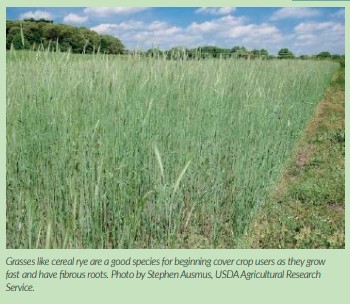
Early Cover Crop Benefits: What Can You Expect In The First Year?
Written By Laura Barrera and first published on AgFuse.com
In 1995, Pennsylvania farmer Steve Groff was speaking at an event when he asked the audience the question:
Do cover crops pay off?
His thinking at the time was that he had been no-tilling since 1982, and maybe if he no-tilled long enough, he wouldn’t need them. Ray Weil, a soil ecologist with the University of Maryland, happened to hear his question and approached Groff about doing a cover crop study on his farm. It turned into a 12- year project, from 1995 to 2007. It was in 1999, four years into it, Groff got the answer to his question. That was the year he had a drought, and the corn that was grown on previously cover-cropped ground out-yielded the corn on non-cover cropped ground by 28 bushels per acre.
“That’s all I needed,” Groff says. “Ever since that I’m totally committed to cover crops.”
Talk to most farmers who have been using cover crops and you may get a similar story. They’re a long-term practice for protecting and improving the soil, which may also translate into protection and improvements for cash crops. The longer you use them, the more likely you’ll see a return on investment. But what about the short-term? Are there benefits growers can experience in their very first year of using cover crops? The answer is: it depends. A variety of factors can influence the early benefits of cover crops, including the soil’s current health and conditions, tillage practices, species selection and overall management.
The poorer the soil, the faster the results
One of the fastest changes that can occur from cover cropping is the improvement of soil health. In the 2016- 2017 Cover Crop Survey Annual Report, 54% of farmers said they believe that soil health benefits from covers began in the first year of use. While covers can help any soil, Groff, who now runs a cover crop consulting business, says that cover crops seem to help a poorer soil quicker.
“If you have 3-foot deep topsoil in Illinois, you’re not going to see a dramatic difference in the soil as you would in maybe another soil that’s on a hillside, or rocky, or sandier,” he says
Eileen Kladivko agrees. The Purdue University agronomist says that one of the earliest changes farmers may see in their early cover-cropping years is an improvement in soil aggregation, especially in soils with low soil tilth and organic matter, such as 1.5% or less.
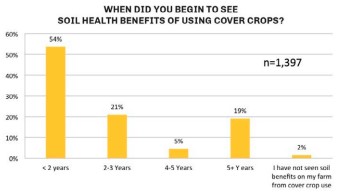
Another potential early benefit is less soil crusting, which can result in better seedling emergence and uniformity. “It depends on the year, it depends on the soil,” she explains. “If you have a severe thunderstorm shortly after you’ve planted and before your seedlings have emerged, having something like a cover crop on the surface can reduce that issue.” That goes in hand with preventing erosion, especially for those growing low-residue crops like tomatoes, corn silage or seed corn.
“And those are also places where cover crops are easier to fit in because they have more time after harvest,” Kladivko says. “You can actually get more growth and different kinds of cover crops, because you’ve got a longer window in the fall to get things established than if you do if you wait until after field corn harvest to seed the cover crops.” She notes that some of these possibilities would be more obvious for famers who are tilling than for no-tillers. “If they’re in no-till and they don’t have any significant erosion problems, then they may not notice that kind of benefit.”
Preventing rills and gullies pays off
While it’s difficult to calculate a return on investment for most of these early cover crop benefits, one effect that can result in a direct economic benefit is the prevention of rills and gullies. One farmer told Kladivko he usually had to fix the beginning formation of rills and gullies on his highly erodible soil. But just one year of cover crops prevented them from forming, saving him time and fuel. “Even if you don’t worry about how much soil is washing down the river — how much of that $10,000 an acre soil you just let leave your farm — the fact that you had to actually go and do something with the beginnings of a gully, to this farmer was worth time and money,” Kladivko says.
Trapping nitrogen now for future crops
Kladivko admits that this does not pencil out for a farmer who is renting land and is looking for a return on one year of cover crops. But for those who own land or will be farming ground for several years, cover crops can keep nitrogen from leaving the field and build up their soil nitrogen bank account. “If 20 pounds of nitrogen was just going down the drain, now you’re keeping it in the field,” she says, adding that covers can scavenge up to 30 pounds of nitrogen. If you’re growing a legume, it’s even more.
Unfortunately, growers can’t “withdraw” from that soil nitrogen bank in the first three years. Most of the nitrogen is recycled into the soil organic matter, Kladivko says, but at some point there will be enough built up that farmers can cut back on their nitrogen. “It’s certainly going into that account, they just can’t draw on it.”
Cover crop top growth can aid water availability and weed control
It depends on how much cover crop growth there is, but if farmers end up with a good mulch from it, that can increase soil water infiltration rates, Kladivko says. It can also reduce evaporation rates from the soil, which means there’s the potential for greater water availability for the cash crop at some point in the summer. “The rainfall that you do get will last you a little longer,” she says. “That’s a potential benefit in year one, depending on the year and on how much topgrowth they allow.” The amount of cover crop topgrowth can also help in the fight against weeds, particularly those that may be herbicideresistant.
“I know some of our weed scientists at Purdue get very concerned with people saying ‘You’ve got cover crops, you don’t need any kind of herbicide or weed control, that’s all you need,’” she says. “But they say it can provide another tool for weed control in addition to herbicide. For winter annual weeds, I think in general they think they can be pretty effective.” In the 2016-2017 Cover Crop Survey Report, 44% of farmers said that while they’ve made no changes in their herbicide program, they’re getting better weed control following cover crops.
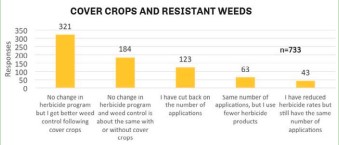
Best cover crops to begin with
For farmers who are hoping for benefits from the get-go, Kladivko says grasses like cereal rye, wheat or barley, are good ones to start with because they grow faster and have fibrous roots. “Something with a fibrous root is going to help hold that soil together and help provide good cover,” she says. For growers looking for some additional weed control, Groff says that cereal rye before soybeans is a good fit. In fact, the Cover Crop Survey Report specifically asked respondents about their experience with cereal rye on herbicide-resistant weed control, and 25% said they always see improved control following cereal rye and 44% reporting “sometimes.” The remaining 31% said they never see improved control.
Groff also recommends pairing oats with radishes, calling them the “cover crops with training wheels” because they’re hard to screw up. They also provide tangible benefits to the soil early on — the word Groff most often hears from growers is “mellow.” That mellowness is more noticeable with radishes because their deep taproot help alleviates compaction, but oats will also improve the soil tilth as its roots die in the spring. Kladivko recommends that radishes not be used alone because their size can leave the soil erodible. Management of the two is easy because they’ll both usually winterkill, so farmers don’t have to worry about having to deal with a living crop in the spring. “It’s easier to plant into, you don’t need special equipment on your planter,” Groff says.
But they do have to be planted on time — at least 6 weeks before your average first killing frost — to achieve decent growth, which may be a challenge for farmers with later harvests in northern locations. Black oats are another good beginner option that can be easily terminated with Roundup or a roller/crimper and decompose quickly for easy planting conditions. Legumes are another species Kladivko recommends for improving the soil structure, but unless they’re established early — in a corn-soybean rotation, they would need to be seeded before either crop was harvested — then they won’t achieve much growth in a fairly short window. In that situation, a grass is a better option.
4 tips for succeeding with cover crops from the start
Groff warns that while cover cropping is a simple concept, being successful with it is very complex. Below are some tips he has for setting yourself up for cover crop success.
1. Treat your cover crops like your cash crops. In all aspects, which includes preparing to plant them, knowing when to plant, and understanding that in some years it’s not going to be as good as others. “Cover crops are just like cash crops,” he says. “Some years they’re phenomenal results and some years they’re lacklustre due to weather and mismanagement.” He adds that cover crops will make a good farmer better and a bad farmer worse. “Just because you have a bad year of cover crops doesn’t mean that you’re a bad farmer,” he explains. “It just takes another level of management. If you treat your cover crops like your cash crops, you’ll stand a much better success rate of making them pay and making them work.”
2. Create or fulfill an existing planting window. Farmers who take wheat off in the summer and don’t follow with a double-crop have the easiest way of jumping into cover crops because they have a wide window of planting and cover crop growth. But for farmers who are growing something like full-season corn and soybeans, their options — and chances for cover crop success — become more limited. “Maybe you need to plant a field of shorter season corn or shorter season soybeans — take them off a week sooner, you’re setting yourself up for success then,” Groff says. “Because we’ve got good varieties out there now that are short-season, you’re not going to really sacrifice yield if you get the right one. You’re setting yourself up for a timely planting where you can actually see a difference. Success depends on management.”
3. Find a mentor. Anyone starting out with cover crops should find a mentor, and that doesn’t necessarily have to be a personal relationship, Groff says. Instead, farmers should look for the people who are achieving what they want to achieve and follow what they do.
4. Choose your own way. Everyone wants a cover crop recipe, but Groff says that like all other aspects of farming, farmers have to figure out their own road map.
“Just like you choose the corn hybrid you plant, the soybean varieties you plant, you don’t plant the exact same thing as your neighbour probably,” he says. “Eventually you’ll do what works on your farm, and that goes from species to seeding rates to creative ways to get them planted sooner.”
-

Drill Manufacturers In Focus…
JOHN DEERE SEE & SPRAY™ ULTIMATE – TARGETED, IN-CROP SPRAYING


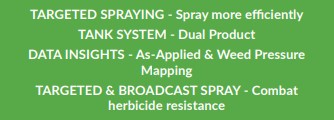
With See & Spray Ultimate, you can gain cost efficiency in your herbicide applications by reducing your spray volume, which in turn enables you to use more advanced tank mixes. We have added to the previously launched See & Spray, to allow in crop targeting of weeds (See & Spray was for fallow ground only). See & Spray Ultimate currently only detects weeds among corn, soybean, and cotton plants. It uses cameras, processors, a carbon-fiber truss-structure boom and a dual product tank. It enables targeted application of non-residual herbicides on weeds within corn, soybean and cotton fields. It can also be used for traditional broadcast application, as well as targeted and traditional spray combined. This strategy reduces crop stress by providing an effective weed-kill strategy, eliminating the chance weeds will rob plants of valuable nutrients and moisture, thus enabling crop roots to thrive. Plus, when using AutoTrac™ technologies, the sprayer will stay between rows and off the crop further reducing potential crop damage.
The dual-tank configuration lets you apply targeted spray and traditional broadcast at the same time, combining two passes in one to save you time and money. Target spray weeds and broadcast fungicide, or better manage weeds by applying a non-residual targeted spray and residual broadcast, all in one pass. Using Targeted Spraying to kill weeds, it can be done at a lower cost by applying only what you need – when and where you need it. Or, with the dual-tank capability of See & Spray Ultimate, use different chemical mixes independently of each other and at different target rates – all on the same pass. Plus, the amount of herbicide saved during Targeted Spraying can be used for a second and third pass during the growing season to address weed control all season long.
MEET SEE & SPRAY ULTIMATE
The cameras and processors are just the beginning. Discover how this See & Spray technology works.
Vision Processing Unit
Multiple processors across the boom use camera vision technology and machine learning to detect weeds from plants, and activate sprayer nozzles all within 200 milliseconds.
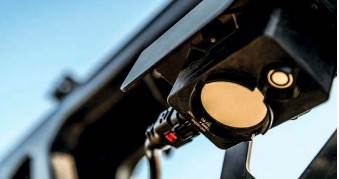
Cameras
36 cameras mounted across the boom scan more than 2,100 square feet (195 m2) at once.
Dual Product Solution system
The tank is split in two, with either 1,000 gallons (3,785L) or 1,200 gallons (4,542L) total capacity. Use two independent tank mixes simultaneously with targeted spray and traditional broadcast spray, or a single, combined tank mix for either targeted spray-only or broadcast spray-only.
ExactApply™ Nozzle Control System
Individual nozzle control with ExactApply offers precise droplet sizing for a consistent targeted spray that also reduces over-application and off-target drift.
Carbon-Fiber Truss-Style Boom
The new, 120 ft. (36.6 m) carbon-fiber truss-style boom is lighter than steel, providing the stability needed to enable targeted spray.
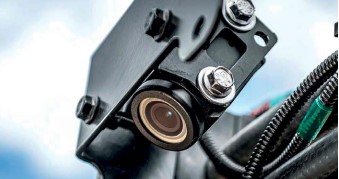
BoomTrac™ Ultimate Height Control
BoomTrac Ultimate ensures consistent height control when traveling across uneven fields for precise application, with 25% better spray accuracy* than the next best manufacturer. *Based on Iowa State University testing; scores represent composite data over a variety of terrains at factory-calibrated settings. Performance varies based on user-specified settings and adjustments. BoomTrac Ultimate tested on MY 2023 412R Sprayer with 36.6-m (120-ft) truss-style carbon fiber boom; NORAC installed on MY 2022 John Deere 4 Series Sprayer with 36.6-m (120-ft) steel boom; Raven AutoBoom XRT installed on MY 2022 John Deere 4 Series Sprayer with 36.6-m (120-ft) steel boom. Operated at 12mph and 30-in.
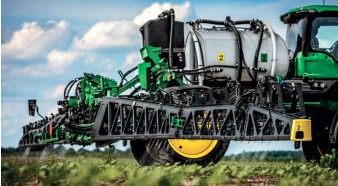
See & Spray™ Ultimate Agronomic Trial: Target Spraying with Dual Product Solution System for Waterhemp in Soybeans at V5 growth stage

Our study was conducted in an Illinois soybean field at the V5 growth stage to target spray for waterhemp in the summer of 2021. Using an enhanced herbicide program consisting of both targeted spray (non-residual) and broadcast (residual) tank mixes, and with higher sensitivity settings to study weed efficacy, See & Spray Ultimate delivered 7% better weed control with 47% less herbicide volume used. These results are made possible by the dual product system, which eliminates in-tank herbicide antagonism that reduces herbicide efficacy. Our agronomic and product experts have and will continue to partner with state universities on additional trials, plus we’ll continue to conduct our own strip trials to ensure our products and technologies help you gain improving yields, cost efficiency, and profitability in your operation.


Questions:
What’s the difference between See & Spray Ultimate and
See & Spray Select?See & Spray Ultimate detects weeds among corn, soybean, and cotton plants. It uses cameras, processors, a carbon-fiber truss-structure boom and a dual product tank. It enables targeted application of non-residual herbicides on weeds. It can also be used for traditional broadcast application, as well as targeted and traditional spray combined. See & Spray Select is for use in fallow ground only. It uses a colour-detecting technology to identify and target spray green on brown soil. See & Spray Select can also spray both targeted spray and traditional spray in one pass, with a single tank mix. Reference chart above for features:

Can I add See & Spray Ultimate to my current Sprayer?
No. See & Spray Ultimate is factory installed on new Sprayers only. It is not available as a Performance Upgrade Kit. What model Sprayers is See & Spray Ultimate available on? See & Spray Ultimate is only available on the 410R, 412R and 612R Sprayers.
What boom sizes are available on See & Spray Ultimate?
The 120 ft (36.6 m) carbon-fiber truss-style boom is the only boom size available for See & Spray Ultimate. What are the dual tank split sizes available on See & Spray Ultimate? The 410R Sprayer has a 1,000 gallon (3,785.4 L) tank with a 650/350 gallon (2,460.5/1,324.9 L) split. The 412R and 612R Sprayer have a 1,200 gallon (4,543 L) tank with a 750/450 gallon (2,839.6/1,703.4 L) split.

-

Farmer Focus – John Pawsey

Since my last submission to Direct Driller Farmer Focus was September, I owe you a report on what we have stuck in the ground for harvest 2022 and how it’s looking at the time of writing.
Buoyed up by my harvest 2021 organic oilseed rape crop, I planted a further crop in August but was persuaded that my previous mix of rape, fenugreek and beseem clover was not the way to go and that rape, buckwheat and a more frost intolerant variety of Tabor beseem clover was a more reliable option. Quite why I didn’t ignore that advice given that my previous crop did so well is beyond me, as the new mix offered my oilseed rape to the flea-beetles for breakfast. It pretty much didn’t even manage a true leaf. I visited David White in Little Wilbraham late in the autumn and his flea-beetle free diverse mix of all-and-sundry plus rape looked amazing. The organic grower can only plant companion species that will be taken out by a frost, whereas David can plant a much more diverse mix to confuse said insect and then tickle the unwanted plants up with a light dose of herbicide. David (allthe-tools-in-the-box) White as I affectionately call him.
I should point out at this juncture to save the younger reader from Goggling the word “frost” an explanation. In the 1970s sometimes the temperature would dip below freezing overnight (I know, it seems crazy. We wore real fleece from sheep in those days, not a pretend one made with petrochemicals), and when we woke up in the morning the grass was all white in the garden because the water on the leaves had frozen into beautiful crystals making everything look like fairy land. Also, the ground froze meaning that there was a huge amount of resistance in the soil and so we could take a 20 tonne tractor and a massive cultivator onto our ploughed fields to do some cultivating without damaging the soil. Now kids, Google “oxymoron”.
My failed oilseed rape crop was re-drilled with vetches which looks fantastic.
We planted our usual amount of spelt which I love as it grows so tall by this time of the year it is taller than any of our weeds which makes the farm look amazing from the road. The same applies to Millers Choice heritage wheat which has the same positive visual effect for my farming neighbours. By the way reader, if you are thinking of growing any spelt, the only variety to grow is Zollernspeltz. Don’t be persuaded otherwise by your seeds-person. If they try and tempt you to grow spring spelt, cancel your account with them immediately as they are idiots or ask for an extra gear on your combine harvester which you won’t be able to afford the repayments on.
We have also planted 25 hectares of Wildfarmed Grain for musician turned farmer Andy Cato. Andy came to Shimpling Park Farm last year and annoyingly he was charming, handsome, knowledgeable and extremely tall. He also has a full head of hair which I always hate on a man. I invited him for lunch and I am afraid to say that Alice Pawsey let herself down and her family down by swooning allover the poor chap. It was pathetic. He then broke one of our kitchen chairs by the simple act of sitting on it. I suggested to Alice afterwards that perhaps he was a little fat but she assured me it was muscle built up during the days when he worked his French farm with horses. Said chair is still broken because, “Andy sat on it”. See what I mean?
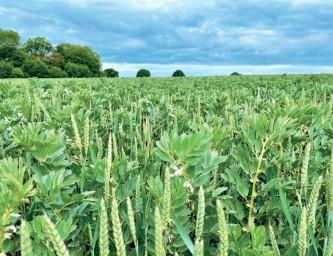
I had the absolute pleasure of going to Andy’s farm in Coleshill a couple of weeks ago and what he is doing there is truly inspiring and I seriously urge you to go if you ever get the chance. It’s mind blowing. I travelled down to Andy’s farm with Alex and John Cherry of Groundswell fame or as I tell my friends, I rode to Wiltshire with Regenerative Royalty. All our winter wheat this year is a 50/50 mix of Extase and Siskin and all our winter beans have been sown with the same varieties with Vespa as a bicrop. Our harvest 2021 bean/wheat attempt was a little light on beans due to a low germination in the beans of 75%, so when it came to separating them in November last year, we had almost exactly one third beans to two thirds wheat but managed to raise the wheat grain protein by a percent which was encouraging. This year’s bicrop has a much better bean establishment and looking at them today I would imagine that the ratio will be reversed. It will be interesting to see what that increased bean yield has on the quality of the wheat.
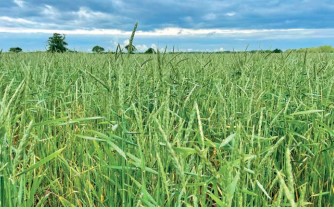
I’ve been pestering Josiah Meldrum from Hodmedod’s for a number of years to grow some of their exotic pulses for them. Apart from Josiah also having a full head of hair (see Cato), he is a really nice man to deal with. There are some companies that whenever you work with them growing novel crops, you get the niggling feeling that you have taken all the risk and the price you get in the end from them didn’t really reward you for your labours. I get a warm feeling when talking to Josiah and so we have got a bicrop in the ground of camelina and entils for him. Josiah said that the lentils will use the camelina as architecture to prevent them from going completely flat at harvest time making their August gathering a joy and I believe him. To be honest, even if it doesn’t work, I will forgive him and grow more next year because he is such a lovely man.
Another great man to grow for is Peter Fairs from Fairking. Peter is the man we grew the first crop of organic chia for last year. If you are interested, it was the first crop of organic chia ever grown in the history of chia growing in the whole of the United Kingdom (just saying). It actually did incredibly well, and although it was relatively uncompetitive with weeds initially, we hoed it carefully once and then it grew up like a forest. I think we harvested it late September and Andrew Fairs (it’s a family company), also having a Claas combine, (they have harvested chia on their own farm but it wasn’t organic, hence my above undisputed claim), texted through the ideal settings and we roared through the standing crop with no problems.
I put some hessian down on our ventilated grain store floors (it’s a teeny tiny seed) and piled the chia in about a metre high and blasted it with ambient air for a few days and then sent it off for cleaning. Anyway, we are growing some more for Peter this year in the same field as the camelina/lentil crop. The field in question is on a south facing slope (riotous laughter as I mention slope and Suffolk in the same sentence), so if they come on flower at the same time, the blue flowered chia below the yellow flowered camelina, means I will have sown a massive Ukrainian flag. I will be charging for photos.
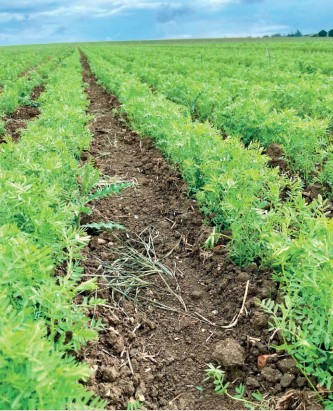
We’ve managed to inter-row all of our crops once, which is all we ever do, apart from the spelt (see above) and all the under-sowing of fertility leys has been completed. Although we have had very little rain this spring to date, our crops still seem to be getting some moisture from our clay soils but the shallowly sown small seeded under-sowings could do with soft refreshing rain to get them going.
As you know, we organic farmers do a bit of cultivation to mineralise some of the goodness we have built up in our leys and to deal with some weeds. This year all of my spring sown crops were established after a green manure, grazed by sheep over the winter and then with three light and shallow passes with a cultivator we managed to get our crops in with much less soil disturbance than usual. You’d be proud of me.
-

Agronomist In Focus…
CHRIS MARTIN FROM AGROVISTA

Industrial farming has been an incredible success story when it comes to increasing production. But many people, including me, believe this era is coming to an end. It is time to rethink the way we go about producing crops.
For the past few decades UK agriculture has become increasingly reliant on the can to control grass weeds, diseases and pests, and on heavy machinery to beat soil into submission to create seed-beds. We’ve been fighting mother nature for the past 70 years, and we now need to work with her. The silver bullets we once had to control all manner of ills are not coming along as often and, when they do, they tend to break down more quickly to resistance pressures.
The ongoing degradation of biodiversity and soil fertility we have experienced is making agriculture increasingly reliant on these synthetic inputs to prop up the system. It will get worse and, at some point, it will fail. Putting things right won’t happen overnight. We need to wean ourselves off this industrial approach and adopt a hybrid model that incorporates the best holistic methods backed up by effective chemistry. We need to switch from degenerative to regenerative approaches.
Done correctly, this will result in:
• Better soil health to help optimise crop health and yield
• Maintained or enhanced crop yields to underpin returns and drive down production costs
• Improved farm profitability through targeted inputs and reduced establishment costs
• Enhanced carbon sequestration to tackle climate change and offer potential new income streams.
Regenerative agriculture has shot to prominence over the past couple of years in the UK, but many people are unsure what it entails. I define it as a system of farming principles and practices that aims to reverse the errors created by previous unsustainable methods.

It works alongside nature to increase biodiversity, improve soils and protect the environment, while delivering benefits to humans through an improved natural environment and healthier ecosystems. The journey towards regenerative agriculture can appear very daunting. However, I cannot emphasise enough that it is not prescriptive – how far people want to go down the more sustainable farming route is a personal choice. It doesn’t have to be all or nothing; very useful effects can often be obtained from quite conservative tweaks, depending on the farm’s current practices, and the process can be undertaken at a pace that suits the individual.
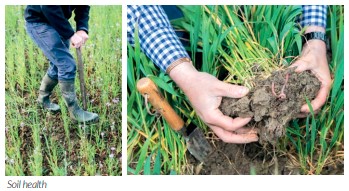
Some people might opt for a complete reboot, reassessing their system and introducing wholesale change. For others, it may be as simple as dropping a pass with a power harrow, or amending the rotation. There are plenty of stops where you can get off along the way.
Full-blown regenerative agriculture is based on five key
principles:1 Limiting physical and chemical disturbance of the soil
Reduced tillage can bring several advantages, including improved soil structure and stability, increased drainage and water-holding capacity and reduced risk of runoff and pollution of surface waters. It also results in significant savings in energy consumption and lower CO2 emissions.
Options will depend on a range of factors, including regional suitability, soil type and drainage, along with soil biology and chemistry, harvest residue management, resistant grass weeds and plant nutrition.
2 Keeping soil covered
Providing the soil with armour by employing cover and catch crops to maintain plant cover/residues at all times will protect the soil from adverse conditions, greatly reducing wind and water erosion and compaction, whilst preventing moisture evaporation and germination of weed seeds.
3 Keeping living roots in the soil
Ensuring living roots are always present will help improve soil structure and nutrient capture, while reducing soil erosion and building soil fertility and nutrition. Living plants are also essential for harvesting sunlight, our greatest resource.
4 Plant diversity
Increased diversity can be achieved by intercropping cash crops, improving crop rotations and using multi-species cover crops. Growing a range of plants across the farm helps to improve crop resilience and optimise yields over time. A good mix of species will build a healthy soil microbial population and improve soil biodiversity, supplying plants with the nutrients they need, which greatly reduces the need for synthetic fertilisers.
5 Integrating livestock
This practice benefits soil health, animal health and the environment. Grazing animals after annual crop harvests aids in the conversion of high-carbon residues to low-carbon organic manure. Grazing on cover crops can allow more nutrient cycling from crop to soil and carbon sequestration into your soils.
By adopting some or all of the above principles to varying degrees that best fit a farm’s individual circumstances, growers can start to improve the sustainability of their systems, building long-term soil health and functionality whilst maintaining farm yields and improving overall farm profitability. So where do we start? There are several things we need to ascertain before any decisions are made: what is the current soil heath status; what does the grower want to do; how can we enable that vision; how can we ensure progress remains on track?
“The journey towards regenerative agriculture is not prescriptive – how far people want to go is a personal choice”
• What is the current soil heath status?
We must first understand the relationship between a soil’s physical structure, its biology and the chemical processes within it. These are the keys to creating and maintaining healthy soils that are essential for crop and livestock production.
The whole process starts with a comprehensive soil test. If you don’t measure, you can’t manage. You have to know the starting point for the physical, biological and chemical properties of your soils.
• What does the grower want/need to do?
What is the main driver – is it long-term soil health, carbon capture, compliance with support schemes, or improving the legacy of the farm, for example? Where is the farmer in terms of the journey and where does he or she want to go? Most importantly, be realistic. Is the land capable of delivering those aims? And what about the bottom line? The financials are often overlooked. Throughout this process, the farm must still make money. Many people say you have to take a hit in the first few years – buy a direct drill and the benefits will come. I fundamentally disagree – if you are not making money, the process will eventually fail, and you are putting your business at unnecessary risk.
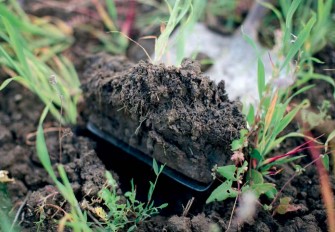
• How can we enable the vision?
We can now decide what action to take, by examining how various farming practices affect soils and what needs to be done to deliver the desired changes. Do we need to rethink the farm’s machinery policy? Is the current rotation suitable to achieve the goals we have set? Do we need to rethink the whole production system?
There is no black-and-white answer – any advice must be tailored to an individual farm’s needs, its ability to deliver, and the timeframe involved, based on the balance of probability of achieving the best outcome.
• How can we ensure progress remains on track?
We need to ensure we are using useful key performance indicators that are, above all, practical. Using definitive numbers may look and sound good, but they are often of limited use. The soil is a living, dynamic medium and I’ve yet to find a soil test that provides a definitive numerical figure that is both meaningful and fully repeatable. We need to be looking for trends to ensure we are going in the right direction, whether that be financial or physical. There is no blueprint for success. We need to bridge the gap between the science and practical farming, and a degree of flexibility will be key.
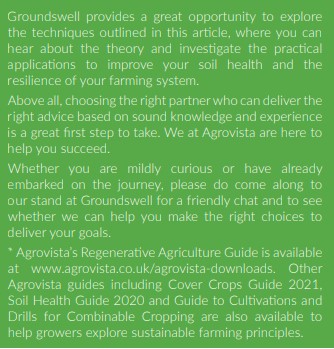
-

Drill Manufacturers In Focus…
HIGH HOPES FOR HARVEST


With crops on the farm showing great promise, output prices at record levels and the family’s agricultural machinery business operating at capacity, Suffolk arable farmer and inventor of the Opti-Till® direct strip seeding system Jeff Claydon is optimistic for the months ahead. But it is tinged with caution, the watchword in today’s topsy turvy world.
25.05.2022
Whilst drafting my last article for Direct Driller, Russia had just invaded Ukraine, provoking military conflict and war in the country. Almost three months later, the catastrophe and humanitarian crisis continue with thousands killed, homes and cities destroyed along with millions displaced and seeking refuge. Global supply shortages have caused sky-rocketing prices with far-reaching and dramatic impacts. In the agricultural sector, global uncertainties and a tightening of exportable surpluses have pushed combinable crop prices to previously unheard-of levels, with wheat currently trading at north of £300/t and oilseed rape over £800/t. Whilst this will benefit the arable sector, those in the livestock and poultry sectors are struggling.
Higher prices are quickly being reflected in the cost of food in the shops and if there is any positive to come out of the current situation it will be to make consumers reassess the importance of farming and what they eat. Back in the 1970s food accounted for a substantial proportion of a typical family’s budget, but over the years governments of all persuasion have prioritised cheap food and it has fallen down the list of most people’s’ priorities. For decades, the public has given little thought to food security, where it comes from or how it is produced; perhaps this will provide a wake-up call and encourage them to focus on the things in life which really matter.
Global agricultural production is forecasted to need to increase 60 per cent by 2050 just to keep pace with population growth. But, even as governments around the world stress the need for farmers to produce more, the legislation which they and other bureaucrats devise and sanction is restricting our access to inputs and stifling yield growth. During the last decade production has plateaued and the current UK five-year average wheat yield is just 8.3t/ha, so something has to give.
A busy time
So much has happened here during the last three months that it is difficult to know where to start. Having just looked around the building site outside my office which will shortly form the new production and assembly area of the Claydon factory that is a good place to start.

With demand for Claydon products at record levels and our order books full for months ahead, I am delighted to see work on the new building progressing apace. Just this morning, for example, the four 3.2t gantry cranes which will move components and completed machines around the factory were delivered and installed. Measuring 36m x 36m, the clear-span building will add 1300m2 to our factory space and double production capacity. The plan is for it to come on stream in the summer, but we will announce that nearer the time. In the meantime, I would like to thank all our customers for their continued support and enthusiasm for the Claydon Opti-Till® System which has helped to generate additional customers and created the need for the new building.
Invest in the future
With production costs skyrocketing and inflation at its highest level for more than four decades, farmers are looking to reduce costs whilst maintaining or increasing production. Rather than squandering any windfall from higher prices by continuing to operate inefficiently, forward thinking businesses recognise the need to invest in equipment and techniques which produce lasting benefits to help secure their future, so interest in Opti-Till® is increasing.
The was confirmed at the start of the week when I and my team welcomed representatives from our distributors in Denmark and Germany who brought with them 25 existing and potential customers to see Claydon products being manufactured and tour our farm. This visit follows a series of visits by our importers and customers from Lithuania, Romania, and Poland. It was organised by Simon Revell, our Export Manager, and was at an ideal time of the year for visitors to see how well Claydon-drilled crops are looking.

As part of my presentation, I showed our guests a slide based on information produced by Harry Henderson, AHDB’s Knowledge Exchange Manager – Cereals & Oilseeds, showing the cost of establishing winter wheat on 20 AHDB Monitor farms and the yields achieved by various approaches. Farm 12, with one of the highest yields of milling wheat but lowest establishment costs, was Rick Davies, a long-standing Claydon customer, who invested in a 3m Claydon Hybrid drill (upgrading to a 4.8m Hybrid in 2015) and a 7.5m Straw Harrow in 2010. Costs will have increased considerably since this data was produced but the proportional costs are really telling the story. When discussing his reasons for switching to the Claydon System in an article published in Crop Production Magazine during 2015 he summed up a number of points so well that I have quoted him in the paragraph below.
“It is no exaggeration to say that the Claydon System has transformed the way we think about farming and how we actually farm. Having used conventional cultivations and become used to seeing perfect-looking seedbeds for so many years, moving to the Claydon System was a huge leap of faith and it took time to get used to the idea that it would look different. But the results prove that you cannot judge a crop by its initial visual appearance and what really counts is how much goes into the combine tank. Now that we have experienced the benefits we continually ask ourselves why we did not consider the move earlier. But had we not done so when we did we would not be in such a strong position today. I am very pleased that we made the transition voluntarily rather than being forced into it by a lack of profitability, as I suspect some will,”
With some customers savings around £250/ha on their establishment costs and enjoying a yield benefit of up to 1.5t/ ha the advantages are obvious. On the Claydon farm our goal is to achieve the highest outputs at the lowest cost, but that does not mean skimping on inputs; far from it in fact. Rather than spending vast amounts on unnecessary tillage we invest in wisely in inputs which enhance and protect the potential value of our farm and crops.
This season all winter sown crops were drilled by midOctober, helped by the fact that Claydon Opti-Till® enables us to establish the crop in 20% of the time, at a fraction of the cost and using 10% of the fuel (<15 l/ha) compared with a plough-based system. High productivity counts for a lot when the weather is catchy, the window of opportunity is limited, and the number of drilling days are limited, while saving fuel has become essential at today’s prices.
A dry start to the year
2022 has brought with it a very mixed bag of weather. Between New Year’s day and today our farm weather station has recorded less than 170mm of rain, much lower than the farm’s long-term average, while April brought more days with overnight frosts than without, slowing the crops’ growth. Despite very little rain since 1 April, they have caught up well, highlighting the benefits of establishing good rooting structures to make best use of the moisture which is in the ground. Whilst driving around the farm this morning I called in at ‘80-acre’, a field which has been managed using the Claydon Opti-Till® System for 20 years and featured in Direct Driller throughout the season. All of it is into LG Skyscraper winter wheat, which despite the lack of rain continues to look very good. To date it has received just 180kgN/ha, plus the T0 and T1 fungicides, but holds great promise.
In the last issue of Direct Driller, I highlighted the importance of drainage and talked about an issue in the corner of that field where a decades-old tile drain had collapsed during the winter, resulting in a significant area becoming waterlogged. I had planned to sort it out after harvest, but the very dry weather allowed local drainage contractor W. R. Suckling & Sons to come in a couple of weeks ago and install new plastic pipes at a depth of 1m. They did an excellent job, and we will cross mole the area in the autumn if conditions allow or go through the following crop of spring oats early next year.
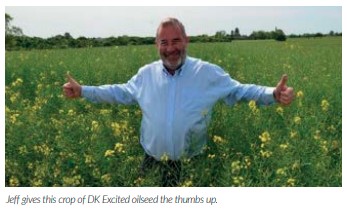
I also called in to check on the progress of our DK Excited hybrid oilseed rape which was drilled within three days of harvesting the previous crop of winter wheat on 15 August. We went directly into chopped straw and stubble using a preproduction version of our new Claydon Evolution drill and a seed rate of just 2.7kg/ha.. Experience has shown that the sooner we can drill oilseed rape behind the combine the better, as the plants are stronger and more able to fend off the Cabbage Stem Flea Beetle. The damp weather and slightly cooler temperatures after drilling, combined with the extra vigour of the hybrid seed, resulted in excellent establishment. Despite having received just 150kgN/ha the crop has developed exceptionally well and looks set to deliver a very high yield at harvest. With rapeseed prices currently around £800/t that would produce a very attractive margin.
This season’s spring oat area is taken up by Lion, a new variety which, according to its breeder Elsoms, combines excellent kernel content and hullability, together with stiff straw and good agronomic package. With seed in short supply, we drilled the crop on 15 March at just 100kg/ha and to date it has only received 50kgN/ha, although another 50kgN/ha will go on shortly taking the total to 100kgN/ha. ‘Lion’, a new variety of spring oats, looks good despite a sowing rate of just 100kg/ha and little rain when this photograph was taken on 18 May.
Even with very little rain since it was drilled the crop looks excellent and last week I went through with a Claydon TerraBlade inter-row hoe to take out grassweeds growing between the band-sown rows before they had a chance to develop and compete with the spring oats. Growing conditions have been much the same as last year when this low input crop achieved over 7t/ha with excellent margins, so I am optimistic that it will produce excellent results.
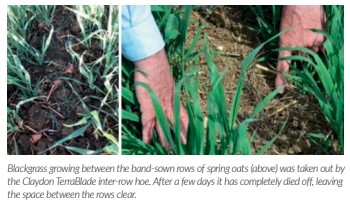
And finally!
After 44 years’ service the roof at Gaines Hall, our Grade II listed 16th Century farmhouse, is being rethatched, this time with wheat straw supplied by accredited master thatcher Harry Roberts of Harry Roberts Thatching Services. Harry is one of the very few who grows his own straw, enabling him to offer a comprehensive field to roof service and ensuring the quality of materials is as high as it can be. He uses straw from Maris Widgeon, now a heritage variety, which was originally developed in 1964 by the Plant Breeding Institute at Trumpington near Cambridge and has traditionally been used for thatching in the UK.

We chose Harry to do the job because he specifies that his straw crops are drilled with a Claydon drill. When I visited the farm which his brother-in-law Sam Clear owns to see it being produced Harry explained that sowing the crop in bands results in the wheat stems being much thicker, more resilient and of higher quality than those drilled at the conventional spacing. The crop is cut with a binder, stood in stooks for two weeks, then threshed in the traditional way to produce the best quality straw for thatching.
Harry is due to complete the work at Gaines Hall in June, so I am looking forward to seeing the final result. I will include a photograph of the finished product in the next issue of Direct Driller, as well as discussing the harvest and our plans for the season ahead.
-

Farmer Focus – Julian Gold

Following directly on from my January ramblings , I was lucky enough to have a couple of frosty nights in early Feb which allowed me to roll 30 Ha of cover crops with our 10 m roll on the controlled traffic wheelings. I got pretty well 100% kill on everything rolled in the early hours before the temperature climbed above about minus 2. The later areas rolled after daybreak did not fully die back and I had to reroll them on the next (and last!) frost of the season to finish the job off.
After thinking for the last few seasons that I was getting negative effects in spring barley following grazed cover crops it was useful to be able to compare the two scenarios properly.The spring barley on both grazed and ungrazed blocks was from the same batch of seed drilled at the same time and the same seedrate with the dale drill.Establishment was approximately 50-60% in the grazed fields and 70-75% in the ungrazed fields and the crop on the ungrazed block has grown away better . I will be surprised if the yield is not significantly higher ( will report back in due course after harvest )

Going forwards I am now thinking that fields destined for spring barley will be subsoiled straight behind the combine and then immediately sown with frost susceptible cover which will not be grazed and will be direct drilled into good soil conditions after frost/glyphosate destruction. I can hear all the die hard “regen aggers” screaming what about livestock integration but luckily you will all be pleased to hear that I still see a need for livestock integration but maybe grazing winter cereals rather than cover crops. For a number of years we have experimented fencing small areas in Winter Barley fields and mob stocking them sheep for a few days . Results have been favourable in that the crop has had less disease through the season and has ended up shorter at harvest time ( good for us as we plant OSR into chopped Winter Barley straw so don’t want much of it ! )
Unfortunately, the areas involved have never been large enough to get accurate yield data from the combine to see whether yield is affected. This year we have grazed a much bigger area alongside ungrazed in the same field so should be able to get yield data. (NIABTAG were involved in a similar trial grazing wheat and sent leaves away for disease inoculum testing which showed massive reductions in Septoria and yellow rust infection in the grazed areas )
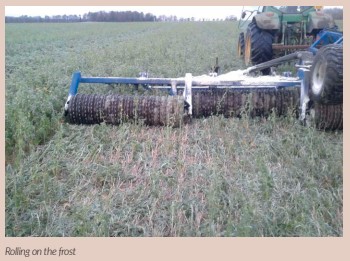
My thinking is that the most appropriate place to use sheep may be in this winter cereal grazing scenario , giving a number of possible benefits : -Reducing disease inoculum -reducing growth regulator use – no detrimental effect on establishment ( like we are seeing in spring barley after grazed covers ) as crop already established before grazing -possibly allows crops to be drilled earlier in September in good soil conditions and then use sheep grazing to obtain benefits of later drilling by removing pretty well all above ground leaf area and hence reduce Septoria and BYDV problems????
I am afraid my penchant for collecting drills is continuing .Following on from my thoughts in my last article we have ordered an Horizon disc drill complete with row cleaners to hopefully prevent the bad hair pinning we have previously experienced when using disc drills.
We have also purchased a Weaving IR drill to fulfil a large annual contract we have got undersowing maize with grass seed. Looking at the drill has also given me an idea for experimenting with it to sow inter row cover crops/clover understoreys in winter wheat in late spring. It already has a spare air outlet on the distribution head and with the purchase of one extra coulter we could space the units at 25cm to match a 6m drill planting cereals at 25cm row spacing. ( presently have the Horizon ordered on 20cm row spacings but wonder if I should be re-thinking that?? )

Moving to wider issues I am concerned that the current worldwide food crisis is starting to trigger comments in the media that UK agriculture should be binning environmental works and concentrating on out and out food production as if the two things were mutually exclusive.
I have an analogy that I like to use: Industrial businesses that have a production process housed in factory premises make their profit from goods rolling off their production line. They then divert some of their profit to maintaining the factory premises .They do this without grants or subsidies or inducements because it is obviously good business sense to ensure the roof doesn’t cave in and destroy the production process. Similarly Agriculture is working within natural ecosystems that I see as the “Factory premises” For too long industrial agriculture has concentrated on the food production line and ignored the “factory premises” The reality is that we should all be prepared to divert profits towards “Factory maintenance” whether or not we are being paid by DEFRA to do so .( Hard Hat on ! )
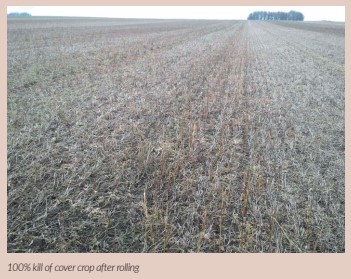
We are trying quite hard to carry out “factory maintenance” at Hendred Estate.One of our efforts is to try to bring as much diversity and habitats onto the farm to sit alongside profitable crop production.We have experimented for a number of years with companion cropping and clover understoreys but have found that there are a lot of practical problems and I am struggling to see how to roll these techniques out on a large scale at the moment. ( Although I applaud the hard work people like Andy Howard and others are doing to make these cropping systems more economically viable )
What we are doing is trying to bring habitats and diversity into fields by planting wildflower strips within fields. To further enhance these strips we have planted an experimental area within one north /south strip with Native hedging and Hazel coppice as a type of Agroforestry system. This should stretch the availability of pollen and nectar for beneficials as well as providing more habitat and carbon capture.
-

Tyre Manufacturers In Focus…
TYRE TECHNOLOGIES TAKING SOIL PROTECTION TO THE NEXT LEVEL

With farm machinery getting increasingly heavier, tyre manufacturers are having to work harder than ever to ensure their products are keeping damage in the field to a minimum. Here we speak to Gordon Brookes, Customer Engineering Support Manager at Michelin, to learn more about the latest tyre technologies and why getting the set-up correct is so important.
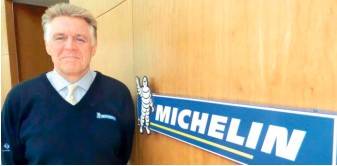
Do you think agricultural operators are paying more attention to their tyres than they have in the past?
In a word, yes. It’s no great secret that farmers with the optimum tyre and wheel configuration, set-up correctly, can reap many benefits over those that tend to overlook this crucial area of their machinery. After all, those large black, round, rubber things at the bottom of your tractor, harvester or sprayer are the only point of contact between the vehicle itself and the ground it’s working on. At Michelin, we have been championing the importance of tyre choice and running the correct tyres for the job, set at the right pressures for many a decade. Today the farming community is arguably better educated about these decisions than at any time previously, and most farmers understand the huge impact their tyres can have on the soil and the productivity of their fields.
Soil damage can hit your yields hard; it increases the risk of disease and can require major regeneration work to put right. For instance, ploughing or de-compaction consumes considerable fuel and time, ultimately hitting you in the pocket. The consequences of rutting can be equally bad, if not worse – nothing grows in a rut! They also encourage water stagnation, which can asphyxiate plants and encourage the development of disease. The latest generations of high technology tyres on the market can really help farmers to reduce soil compaction and minimise rut formation – so it just makes perfect economic sense to opt for these over standard tyres.
What are the key things to consider when choosing your agricultural tyres?
The first step in the process is making sure you pick the right tyres for the application. You need to consider; where is the tyre going to be working – is it going to be mainly used in the field, or will it be doing a lot of road work? Other things to ask yourself, include; how big a tyre do you actually need for the power of your tractor, what loads will you be carrying, what implements do you intend to use, how are they operated in your system and how much load is required to transmit the power? Once you’ve considered these main points, you’ll be in a better place to make your selection although other considerations may still be required. If possible, it’s always worth specifying your preferred choice of tyre as original equipment. Although it may cost a little extra, getting the right tyre on your new machinery is worth the additional expense. Often, when people buy a new machine, it won’t arrive with the most appropriate fitment for the job they want to use it for.
Not every tyre offered by the manufacturer is necessarily suitable. For instance, it may be able to handle the tractor in its naked capacity, but as soon as you stick a big heavy plough on the back, you may find that the tyres are not big enough to support that piece of equipment. Getting it right at the start is definitely cheaper in the long run. If the tyres can’t cope with the power, for example, then you can end up shredding the rubber in next to no time. Those tyres may have been a few hundred pounds cheaper than the ones you needed, but they’ve suddenly become a very expensive mistake!
How has tyre technology changed and moved forward in recent times?
It is approaching 40 years since Michelin first introduced flexible wall radial tyre technology into agriculture and since then, with the debut of even more flexible products including the Michelin EvoBib, CerexBib and AxioBib ranges, Michelin Ultraflex Technology has proved that tractor tyres can serve more than just one purpose. By using Ultraflex Technology, the tyre can not only be used to improve tractive performance and reduce compaction in the field, but also it can significantly improve ride comfort, handling and fuel-efficiency on the road.
But, perhaps most importantly of all, running the right tyres at the right pressures will also minimise soil damage, which subsequently improves your yields. Indeed, it has been scientifically proven by the agricultural experts at Harper Adams University that farmers utilising Michelin Ultraflex Technology tyres can improve yields by 4 per cent in comparison to standard tyres. While the price of these premium fitments may be a little more costly than a standard agricultural tyre, the study also found that any increase in the initial outlay would be paid off within 12 months. And so effectively, once you have paid for your tyres in year one, you’ve recovered your investment, and typically farmers would be running those tyres for a lot longer.
Are there high-tech, low pressure tyres available for all agricultural applications?
Since the first Michelin Ultraflex Technology tyres were introduced to the market in 2004, we have been constantly developing and upgrading the portfolio to bring further improvements to performance and expanding the size range of these fitments, allowing them to work on more and more machinery.
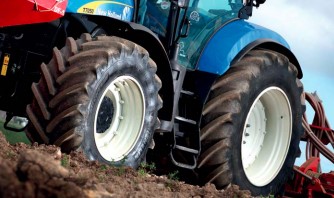
Michelin’s Ultraflex range is designed to cover the entire crop growing cycle, the full line-up available in the UK and Ireland includes AxioBib, AxioBib 2, EvoBib, XeoBib and YieldBib tyres for tractors, CereXBib and CereXBib 2 tyres for combines and forage harvesters, FloatXBib for self-propelled spreaders, SprayBib fitments for high-clearance sprayers, plus TrailXBib and CargoXBib High Flotation tyres for trailers. These products have a larger footprint than conventional tyres, spreading the weight of the machine over a larger ground area. Increasing contact with the ground improves traction and decreases wheel slippage, which in turn allows farmers to spend less time in the field; improving productivity and saving fuel.
Ultraflex Technology tyres really can make a huge difference to soil protection. To put the 4 per cent yield improvement proven by the team at Harper Adams into perspective, the study suggested that if all agricultural vehicles in the main wheat-growing areas of the world fitted Ultraflex tyres, 23 million additional tonnes of wheat would be produced each year – that’s a pretty significant figure!
What are some of the latest products from Michelin to hit the market?
In 2020, the Michelin TrailXBib was launched – enabling farmers to equip their entire tractor and trailer combination with Ultraflex technology tyres, with the choice of AxioBib 2, XeoBib and YieldBib ranges for the tractor, and now TrailXBib for the trailer – meaning users can optimise the efficiency of their operation throughout the crop cycle.
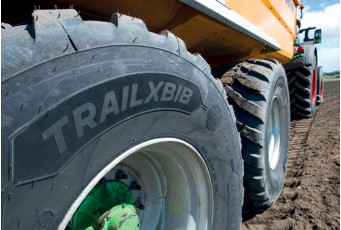
Earlier this year, the Michelin SprayBib CFO was introduced to complement the non CFO SprayBib. Designed for sprayers or other applications that require narrow tyres, the SprayBib CFO offers increased load capacities of up to 14 per cent compared to the previous generation in cyclic field operation at 30 kph. While a reinforced casing allows added axle loads of up to 1.3 tonnes (depending on tyre size) at up to 65 kph.

Both ranges – as with all of Michelin’s latest generation Ultraflex Technology tyres – benefit from a robust VF (Very High Flexion) casing. The VF rating sets new standards in the market, allowing the tyre to carry 40 per cent more load at the same pressure than a standard tyre. By opting for these latest generation Michelin tyres, farmers can also utilise central tyre inflation systems (CTIS) – such as the MICHELIN Group owned PTG CTIS technologies – allowing them to easily adapt the pressures they are working at, at the touch of a button.
It’s these constant upgrades that keep us ahead of the game when it comes to supplying the best agricultural tyres on the market. Huge amounts of time and money has gone into the research and development of these products, with the overriding focus to help farmers and contractors to get the absolute maximum performance from their machinery.
We understand the challenges faced by those working across the agricultural sector and are committed to playing our part to create a sustainable and responsible future for the industry.
-

Farmer Focus – Neil White

As I write I am sure we are all looking forward to Groundswell, getting off the farm is an important thing for many reasons. I still tell people about last years’ experience and how much I learnt.
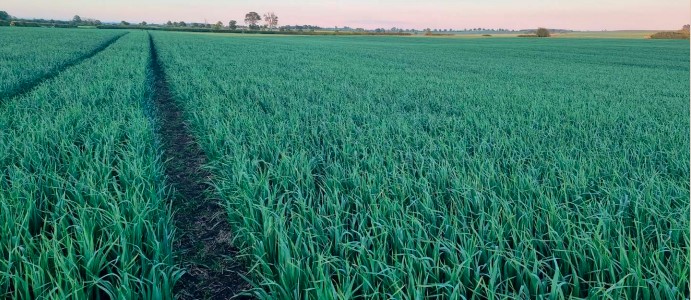
What a time to be a farmer, who could have predicted the chain of events leading up to this point, and I can’t see anybody being able to confidently predict the next 12 days never mind 12 months!? Events have brought production costs and margins into sharp focus and the increased cost for many systems will be prohibitive. Its times like this I’m glad I looked at and started down a direct drilling route. Cutting out any prior cultivation means that although my Mzuri does move some soil and create tilth it establishes crops on my ground as efficiently as possible. I do still plough around 10% of my ground after drainage work or potatoes but that is also sown mostly with the Mzuri as this allows variable seed rate and placed fertiliser at sowing. I am up to 90% direct drilled now as the two systems, plough/power harrow drill and direct drill, run together for years were producing similar yields at very different margins.
This year I tried a winter cover crop consisting of Phacelia, farm saved beans and buckwheat. I looked at various mixes but following lots of American research, went for a simple 3-way mix. The research shows that below ground a 3-way mix can add as much as any larger mix and I was able to cheapen it further by using farm saved spring beans. This mix was sown Sep 3rd at 12kph one pass after the previous wheat crop was removed. In Scotland we are usually waiting for ground to dry enough so we can get on sowing, so an open cover was essential. The cover got a great start and finally the frost killed the buckwheat around Dec 1st, the cold also checked the beans enough to keep them manageable, the roots had lots of nodules, so job done.
Everything was then sprayed off, hen muck spread, and then Canyon oats for Quaker sown variable rate into the cover. We had a dry spell after sowing and while the oats emerged well, they maybe didn’t tiller quite as much as usual, I don’t know if this was just the dry or maybe something from the cover, but the ground conditions at sowing were ideal. The roots of the cover had kept the soil moist and loose, and the worm action made it appear like a grow bag mix. I only added 60kg of bagged N and today they look good. If the yield is good, it is something I will try again but maybe with a further reduction in applied N.
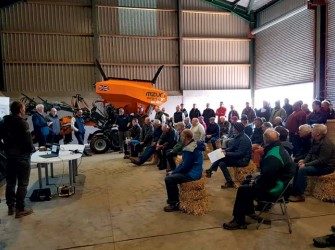
I did a few contract jobs for this harvest. Two of them were wheat direct into grass leys and then an interesting trial involving the Hutton institute. The trial, sown in April, was for a poultry farmer who is looking to grow home grown proteins in the mix making up his ration. This will be cut in one go with his combine. First sowing pass, beans 3 inches deep, and either side out the coulter 1-inch-deep spring wheat. 2nd pass I nudged the GPS between the rows and at 1.5inches deep the peas and either side 1inch deep, Lupins. No peas on the tramlines, then plots of each individual crop. It got off to a difficult start capping a little in some wet then very dry weather, but I think this will be very interesting to see how it develops, I must admit combining it could be the real challenge.
Back at home I held an open day on behalf of NFUS and it turned out to be a big success. We had 60 people in the shed and field walk, all looking at my system and crops. I think we were all ready to come out and kick some tyres again. Some good questions, from glyphosate use to mistakes I’ve made in the past. I do wish I had taken photos of the terrible spring barley or osr that I had at the beginning. At the time I was just glad to learn and move on, not expecting to be telling others about it later. There is a huge interest in reduced tillage, and this magazine, I think Groundswell and honest feedback has helped me a lot, my concern is the Scottish government, and many others are becoming experts on what is best for my farm. Knowledge transfer must be run with a farmer-to-farmer focus, not just ‘experts’ or industry advisors at inflated prices.
I still don’t believe we have a reliable and standard way to measure farming’s carbon footprint, but we are pushing on with grants, audits and soil testing not knowing ultimately what they hope to achieve! We face a dwindling choice of chemicals; I am practicing reduced use and IPM but a lack of choice usually compromises the effectiveness of a spray program. Like the improvements I have made on my farm, success comes through a combination of many methods, plant breeding, new chemistry, soil health, knowledge and tech must all be invested in and properly explored to maximise output on reduced inputs thus reducing our environmental footprint.
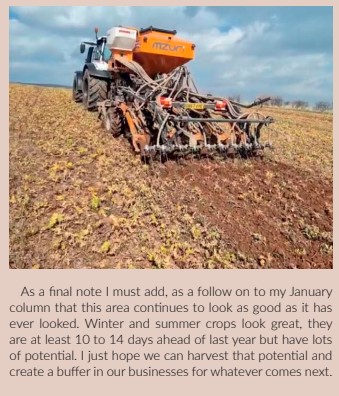
-

Drill Manufacturers In Focus…
STRIGER STRIP-TILL FOCUS

In response to the growing interest in minimal tillage cultivations, KUHN has developed its Striger strip-till range and will be showing the machine at Groundswell 2022.
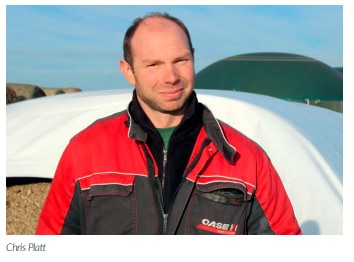
Available from 4 to 12 rows, the Striger 100 is designed around a parallelogram system that allows all elements to operate independently, ensuring excellent ground following characteristics. To achieve the optimum conditions for seed germination within the cultivated row, the Striger 100 comprises six key elements:
1. Ground following is achieved using the hydraulic parallelogram and the gauge wheels, with each element being independent of the frame and the other elements.
2. The opening disc cuts through any plant residues and creates a slot ready for the leg. As an option, a corrugated disc can be fitted which offers a better expansion of the furrow before the leg passes through.

3. Debris clearers remove any residue from the seed furrow to provide a clean seedbed. They can be lifted out when work is resumed in spring.
4. The leg and point cracks and loosens the seed furrow to allow good development of the roots. Working depth can be adjusted between 7 and 30cm without tools. To prevent soil ingress from the inter-row, the leg is independent from the deflector discs.
5. The deflector discs channel the flow of soil while creating a fine tilth. The inter-row remains intact and weed emergence is significantly reduced.
6. The rear press wheels reconsolidate the seedbed and avoid cavities in the seed furrow. The pressure is adjustable, and the press wheels can be raised during a pre-winter pass.
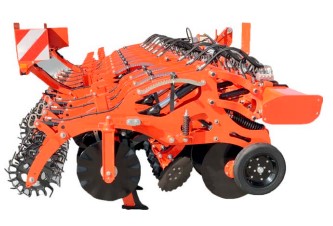
The Striger 100 can be adapted to work effectively in all conditions and can accommodate liquid, solid or slurry fertiliser applications. It can be used with varying inter-row widths and with a wide choice of working parts and equipment. It is available in 3m, 3.50m, 4.40m and 6m formats.
Yorkshire farmer, Chris Platt has improved soil health, reduced labour and fuel and saved time by choosing to strip-till his land. He has also introduced a way to use the machine to inject liquid digestate from his anaerobic digester before drilling maize.
Using the Striger, he makes only one pass before drilling maize which has brought huge time, fuel, and labour savings to the farm. “It is our primary crop, so any economies we can make will all be seen when it comes to harvest. We used to spread the digestate on the land first then plough and then do another pass with a power harrow before being able to drill. To drill he uses an 8-row KUHN Maxima TI L-E and alters the row spacings to enable it to follow the 6-metre Striger. “I can easily alter the row spacings from 750mm to 500mm. I have found this increases yield because the crop is competing for space, but still dies off in time for harvest. In the season to come we are going to use 12 rows rather than 8. This will make it slower, but we will still do more in the same time. 12 outlets will make it easier to regulate the slurry too because we will have more outlets to apply into.”
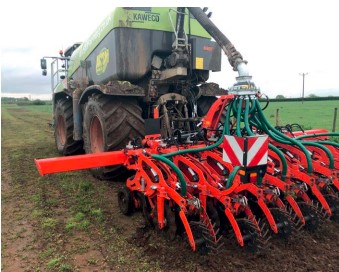
The one pass system also conserves moisture which is important when he moves from the water-hungry rye to maize in the summer. Making decisions on the farm has been made increasingly difficult by fluctuations in the weather. “2018 was dry, and we had to irrigate immediately after planting the maize. However, the one pass system conserves ground moisture, reduces machinery and cuts the reliance on labour by four men. This means I no longer need to work in slurry after a contractor has applied it, which helps to keep moisture in the soil.” The Striger has also helped Mr Platt to reduce the amount of diammonium phosphate (DAP) that he uses, because he is able to apply liquid digestate more accurately. “By using more liquid digestate we have reduced our DAP inputs. 30 cubic metres per hectare was the figure we settled on and my agronomist was very impressed with the way the Striger got the strips just right. He subsequently calculated that when we were spreading conventionally, we were losing 30% of the digestate compared to injecting it with the Striger.”
In the future he is looking to further utilise the Striger for oilseed rape (OSR) cultivation. “Growing OSR is becoming more attractive, and it will make use of the Striger in the autumn. I can use it to cultivate a harvested wheat field, and OSR can take more slurry which will help us to be more efficient as the windows for applying slurry are shorter,” he concludes.
-

Nitrogen Fertiliser Application Strategies Explored
Written by Mark Topliff – Lead Analyst: Farm Economics

It’s been a challenging time for growers wondering what to do around their fertiliser buying and application strategies off the back of higher prices over the last few months. However, using one of AHDB’s virtual farm models, analysis of the most common approaches shows that you won’t go far wrong with any of them.
Five scenarios were explored based on three main approaches:
1. applying at the usual economic recommended amount in 2022 and 2023,
2. apply 75% of the typical application rate each harvest year 2022 and 2023 0. using July 2021 and 2022 fertiliser prices or 1. using November 2021 and 2022 fertiliser prices
3. apply 50% of the typical application rate each harvest year 2022 and 2023 0. using July 2021 fertiliser prices or 1. using November 2021 fertiliser prices
The virtual farm crops 428ha with 66% down to feed and milling winter wheats, 8.5% winter beans, 7% winter oilseed rape and 18.5% spring feed barley. The analysis used this rotation to examine five potential nitrogen (N) fertiliser strategies. Results were calculated as total crop output minus total fertiliser cost – margin over fertiliser. The figures also took into account the impact on yields and futures prices of grains and oilseeds. Yields were predicted to fall 2% under the economic optimum for winter feed wheat compared to 11% if AN (ammonium nitrate) fertiliser was applied at half rate. For winter rape this was a decline of 3% under the economic optimum and a fall of 9% if AN applied at 50% of the typical amount.
When averaged over 2022 and 2023 harvest years there was no real difference between the margins over fertiliser for the three scenarios where AN fertiliser was bought on July 21. Between £1,871 to £1,885/ha. The highest margin being due to higher use of N fertiliser in OSR and barley and hence less impact on yields. It was no surprise that scenarios 2b and 3 b’s margins at £1,814 and £1,769/ha respectively were lower if fertiliser was bought at the higher prices in November 2021.
The right strategy will depend on the attitude to risk to yields and where you feel fertiliser and grain prices will go over the next 18 months or so. However, according to this scenario analysis, there is no significant difference between these expected common approaches. So whether fertiliser was purchased before the higher prices of late or not, some judicious reduction in application rates will pay off.

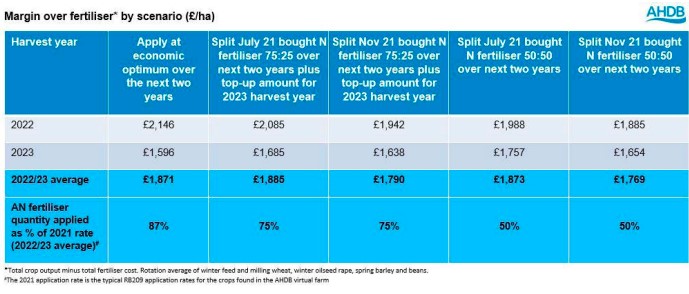
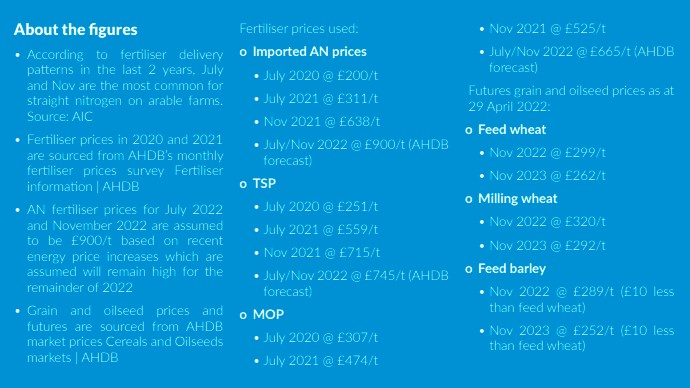
-

What Could The Impact Be On Harvest 2023 From High Input Costs?
Written by Vikki Campbell – Arable Market Specialist Manager

I have looked through the impact Mark’s nitrogen fertiliser application scenarios (previous article) could have for harvest 2022. But what about harvest 2023?

We looked at gross margin calculations for harvest 2023, the reality showing that, unsurprisingly, margins could well be squeezed to a greater degree next season due to the higher input costs. These higher input costs could see some either reduce their nitrogen applications, reduce their cropping areas, or both. These adjustments could be necessary for businesses to optimise their margins, or because of a less liquid cash flow. So, for harvest 2023, there are a couple of variables we need to consider. Firstly, there are the adjustments in nitrogen fertiliser application. Secondly, there are potential reductions in area of certain crops. The scenarios below outline the potential implications of these variables on production for the 2023/24 marketing year.
Introducing the different scenarios
Four different options have been considered for this modelling work.

The first would be a benchmark i.e. assuming there is no difference in area for harvest 2023 than that estimated by the Early Bird Survey for harvest 2022. The following three scenarios all see key cropping areas reduce by a set percentage. Wheat is assumed to see the greater area reduction, due to the higher input costs. Area reductions are taken against the area forecast in the Early Bird Survey for harvest 2022. Against these different area scenarios, the following nitrogen fertiliser application strategies are overlayed.
These options, originally explained by Mark’s analysis, would see fertiliser either applied at the economic optimum, 50% of typical application rates or 75% of typical application rates. A point to note here is that the higher input costs for next season would see a yield reduction in all three cases.
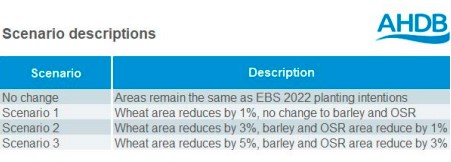
If we take a no change in area to be based upon the planting intentions for 2022 outlined in the Early Bird Survey this year, the rise in input costs mean that if fertiliser is applied at the economic optimum, a reduction in production is seen across all crops.
So, what could the impact be on production for harvest 2023?
The table below highlights that, in all circumstances, we could see a production decline in wheat, barley and oilseed rape (OSR) for harvest 2023. The most minimal impact would, unsurprisingly, be felt if no area change is seen on the year and fertiliser is applied at the economic optimum. Moving down the scenarios, the greatest impact is felt with the largest area reductions and at 50% application rate of fertiliser.
However, there are several key points and caveats that need to be taken into consideration with this modelling work. Firstly, these production figures are assuming average yields. Obviously, there is a lot of time and weather between now and harvest 2023 that can affect growing conditions. Secondly, there is the fluctuation of fertiliser price and availability, particular over the coming months when it will be being purchased. The most recent anecdotal quotes for nitrogen fertiliser are around £705/t, a fall from the £839/t being quoted in March.

However, availability remains challenging and further price volatility is not off the table, especially considering the current natural gas forward prices. Thirdly, there is the price of grain itself, and the potential margin it could offer for growers. UK Nov-23 futures closed yesterday at £270.65/t. This is a rise of £96.60/t since the contract opened last July and £106.15/t more than where the Nov-22 contract sat at this point last season. And fourthly, if farmers cut area in the light of higher input/fertiliser costs, they will normally cut least-productive land first. This could mitigate the yield impact from fertiliser application reduction to some extent.
What could this all mean?
All the while the global supply shocks continue, driven by the conflict in Ukraine and weather worries in global exporters, volatility in both input and output costs will remain. As ever, margin is a key element when considering planting intentions. However, the availability of cash flow could be a hurdle for some when looking to optimise crop potential.

-

Analyst Insight: How Are Margins Looking For Harvest’ 22 And 23?
Written by Megan Hesketh – Senior Analyst – Arable


We are fast approaching harvest 22 and looking now to harvest 23 for cropping decisions, but the cost and margin picture looks very different to this time last year. UK feed wheat new crop futures (Nov-22) closed yesterday at £340.10/t. This is almost double the price from this time last year, where new crop futures (Nov-21) closed at £178.75/t (18 May 2021). A tight supply and demand balance for grains across the board, intensified by the outbreak of war between Russia and Ukraine, has driven values to record highs in recent months.
Though input costs have been rising too. This season-to-date (Jul-Apr), UK produced AN (34.5% N) prices have averaged £601.00/t, up 138% (+£349.00/t) from the average over the 2020/21 season.
Today, I explore how this changing picture has impacted on gross margins. The aim of these figures is to not directly indicate how much profit can be made by each crop, because variable costs will differ by farm. It is more to understand a difference in profitability by year, and to support decision making for harvest 23 cropping. These figures may also give an indication of what the UK planted area may look like too.
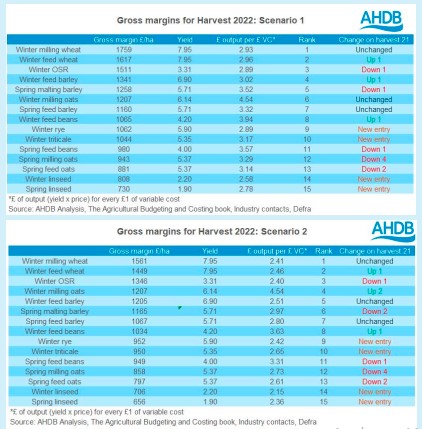
Harvest 22 – costs high but prices higher…
Using two scenarios, profitability between crops can be assessed for harvest 22. For many businesses, the story will rely on price paid for fertiliser and this impact on variable cost for harvest 22. The first scenario takes an average season-to-date for UK produced AN 34%, Muriate of Potash and Triple Super Phosphate. The second scenario takes the top recorded prices this season for these three fertilisers, to compare profitability. Perhaps to no surprise with strong global wheat values supporting UK feed wheat futures, milling wheat and feed wheat are top performers in both scenarios. Though the difference in the price paid for fertiliser makes a large difference in gross margin.
For the milling wheat premium for harvest 22, this uses an average for the 2021/22 season to date. This season’s average has been higher on the year due to the current tight supply and concerns around milling wheat availability. As such, milling wheat gross margins look attractive for harvest 22 especially in scenario 1. Oilseed rape follows closely behind, considering high prices supported from inelastic demand for rapeseed and rapeseed oil. However, new-crop (Nov-22) prices are lagging previous May-21 highs, as supply is expected to improve globally next season. However, crush demand is set to be firm also, which could keep balances tight in the first half of the marketing year.

Linseed, however, is understood now to be trading separately to oilseed rape. As a result, this crop may not have benefitted to the same extent from rapeseed’s price highs.
Harvest 23 – prices lower than harvest 22, but costs to
remain high?Looking to harvest 23, costs look to remain high. Nov-23 UK feed wheat futures prices too look to be firm. Yesterday, the contract closed at £280.20/t. Though is this enough to offset high prices?
Using AHDB forecasts for potassium and phosphate costs, and using CF fertiliser’s latest price for September delivery, margins look to be squeezed compared to harvest 22.
Even if there was a timely end to the war in Ukraine, destruction to Ukraine’s export infrastructure will cause longer term challenges. This adds to the global tightness outlook for the medium term, still further supporting 2023 wheat prices. As such, milling wheat and feed wheat remain top performers. However, the difference between the two looks narrower than harvest 22. For harvest 23, we have used a 5-year average premium to calculate the milling wheat price. This is despite the past two years seeing firmer premiums. Should the milling wheat balance remain tight next season, we could see this premium increase, especially as harvest 23 approaches.
Looking to other crops, milling oats performed higher than winter rapeseed for harvest 23. We can explain this through reduced applications of fertiliser filtering into reduced variable costs. Winter rapeseed margins look to remain favourable for harvest 23. Will the price incentive be enough for farmers to consider growing more? There are still the same issues surrounding cabbage stem flea beetle (CSFB) and impact on yield. But this year’s crop conditions have not noted significant damage.
However, in regard to break crops, feed beans and winter triticale look to deliver a higher output per £1 spent on variable cost. The pulses market can be variable at times, but crops require lower inputs and benefit fields though nitrogen fixing. Something to consider in another high-cost year.
Conclusion
Perhaps unsurprisingly, when you purchased your fertiliser and how much you paid for it will be a big factor in your gross margin picture for harvest 22.
Looking forward to harvest 23, UK feed wheat prices look firm for Nov-23, but rising input costs will be a challenge. Purchasing your fertiliser will be something to think about, considering prices for AN are now available for September delivery. However, cash flow will remain a key concern to many, given the increase in input prices.
Also, a price output per £1 spent on variable cost will be something to consider, given the rising cost picture. For help assessing how your farm performance currently, Farmbench is a useful tool available from the AHDB.
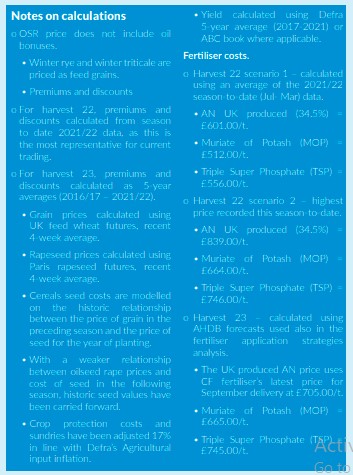
-

Analyst Insight: How Are Margins Looking For Harvests’ 22 And 23?
Written by Megan Hesketh – Senior Analyst – Arable


We are fast approaching harvest 22 and looking now to harvest 23 for cropping decisions, but the cost and margin picture looks very different to this time last year. UK feed wheat new crop futures (Nov-22) closed yesterday at £340.10/t. This is almost double the price from this time last year, where new crop futures (Nov-21) closed at £178.75/t (18 May 2021). A tight supply and demand balance for grains across the board, intensified by the outbreak of war between Russia and Ukraine, has driven values to record highs in recent months.
Though input costs have been rising too. This season-to-date (Jul-Apr), UK produced AN (34.5% N) prices have averaged £601.00/t, up 138% (+£349.00/t) from the average over the 2020/21 season.
Today, I explore how this changing picture has impacted on gross margins. The aim of these figures is to not directly indicate how much profit can be made by each crop, because variable costs will differ by farm. It is more to understand a difference in profitability by year, and to support decision making for harvest 23 cropping. These figures may also give an indication of what the UK planted area may look like too.
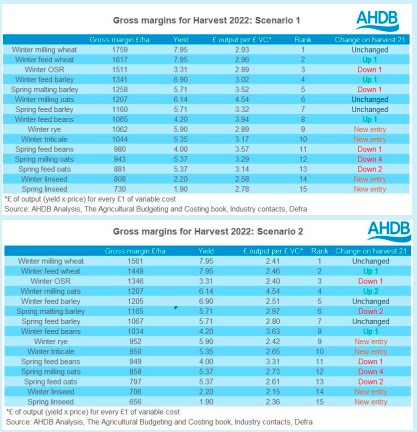
Harvest 22 – costs high but prices higher…
Using two scenarios, profitability between crops can be assessed for harvest 22. For many businesses, the story will rely on price paid for fertiliser and this impact on variable cost for harvest 22. The first scenario takes an average season-to-date for UK produced AN 34%, Muriate of Potash and Triple Super Phosphate. The second scenario takes the top recorded prices this season for these three fertilisers, to compare profitability. Perhaps to no surprise with strong global wheat values supporting UK feed wheat futures, milling wheat and feed wheat are top performers in both scenarios. Though the difference in the price paid for fertiliser makes a large difference in gross margin.
For the milling wheat premium for harvest 22, this uses an average for the 2021/22 season to date. This season’s average has been higher on the year due to the current tight supply and concerns around milling wheat availability. As such, milling wheat gross margins look attractive for harvest 22 especially in scenario 1. Oilseed rape follows closely behind, considering high prices supported from inelastic demand for rapeseed and rapeseed oil. However, new-crop (Nov-22) prices are lagging previous May-21 highs, as supply is expected to improve globally next season. However, crush demand is set to be firm also, which could keep balances tight in the first half of the marketing year.
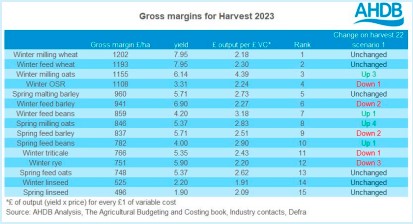
Linseed, however, is understood now to be trading separately to oilseed rape. As a result, this crop may not have benefitted to the same extent from rapeseed’s price highs.
Harvest 23 – prices lower than harvest 22, but costs to
remain high?Looking to harvest 23, costs look to remain high. Nov-23 UK feed wheat futures prices too look to be firm. Yesterday, the contract closed at £280.20/t. Though is this enough to offset high prices?
Using AHDB forecasts for potassium and phosphate costs, and using CF fertiliser’s latest price for September delivery, margins look to be squeezed compared to harvest 22.
Even if there was a timely end to the war in Ukraine, destruction to Ukraine’s export infrastructure will cause longer term challenges. This adds to the global tightness outlook for the medium term, still further supporting 2023 wheat prices. As such, milling wheat and feed wheat remain top performers. However, the difference between the two looks narrower than harvest 22. For harvest 23, we have used a 5-year average premium to calculate the milling wheat price. This is despite the past two years seeing firmer premiums. Should the milling wheat balance remain tight next season, we could see this premium increase, especially as harvest 23 approaches.
Looking to other crops, milling oats performed higher than winter rapeseed for harvest 23. We can explain this through reduced applications of fertiliser filtering into reduced variable costs. Winter rapeseed margins look to remain favourable for harvest 23. Will the price incentive be enough for farmers to consider growing more? There are still the same issues surrounding cabbage stem flea beetle (CSFB) and impact on yield. But this year’s crop conditions have not noted significant damage. However, in regard to break crops, feed beans and winter triticale look to deliver a higher output per £1 spent on variable cost. The pulses market can be variable at times, but crops require lower inputs and benefit fields though nitrogen fixing. Something to consider in another high-cost year.
Conclusion
Perhaps unsurprisingly, when you purchased your fertiliser and how much you paid for it will be a big factor in your gross margin picture for harvest 22.
Looking forward to harvest 23, UK feed wheat prices look firm for Nov-23, but rising input costs will be a challenge. Purchasing your fertiliser will be something to think about, considering prices for AN are now available for September delivery. However, cash flow will remain a key concern to many, given the increase in input prices.
Also, a price output per £1 spent on variable cost will be something to consider, given the rising cost picture. For help assessing how your farm performance currently, Farmbench is a useful tool available from the AHDB.
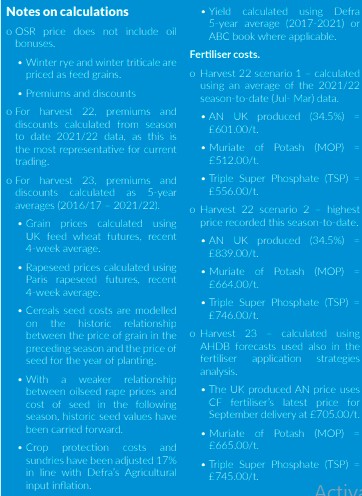
-

Farmer Focus – Tim Parton

Yet another challenging Spring! Don’t you just love farming! It’s what I love most even though I moan (according to my wife) but if it was easy, everybody would want to do it! Every year is a new challenge, bringing new decisions, sometimes things go wrong sometimes they work spectacularly well.
Canola was drilled the first week of September in a field crawling with Flea beetle (even I was concerned). As usual I started the plant off with placed balanced nutrition and much to my delight the flea beetle disappeared, since no food was available because the plant was synthesising correctly, putting the right sugars out as exudates and not having a build-up of mono saccharides (within the plant), which is pure food for the beetles. All Canola was drilled with white clover, Burseem clover and Crimson clover. First time for me growing Crimson clover which is quite dominant and has certainly taken over in any poor patches! Problem or opportunity? I always try to look for the positives in life, so a new riddle has been ordered for my Grain cleaner, which hopefully will enable me to clean out the clover and re-grow! Ever the opportunist.
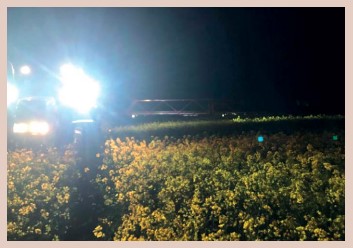
I have 14 different trials on the go this Spring which as you all know generates work within itself. If I have a new idea, I need to get on with it or I’d have to wait a whole year before trying it out. Nick Woodyatt and I have been kept busy as ever keeping the farm moving forward. Wheat has been grown with 50kg of soil applied N and then monitored through sap testing at Novacrop. I gather a lot of people have had trouble getting samples across, maybe I have been lucky, but all samples so far have gone through fine. I am using the amide N from Aiva fertilisers which I apply with whatever nutrient the plant requires to keep it balanced.
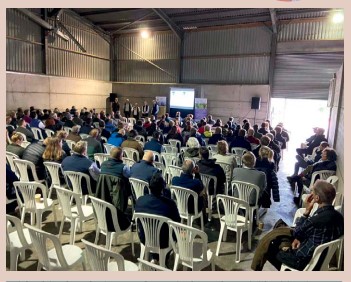
At the time of writing once again no fungicides have been used, with the wax on the wheat leaves simply glowing and standing proud with its full armour on ready to withstand attack! I am growing some Spring barley with just amino acids this time being an Organic form from Mike Harrington and more Carbon positive. “What do points make?……. Money!” (in the form of more Carbon to sell). Results will be revealed in my next article along with the other trials. Most foliar applications are now done at night since there are obviously no UVs (scorch or biological terminator) at this time. Additionally, the plant does 80% of its growing while most of the general population are asleep, which is the perfect time to add a foliar in my opinion with test results backing this up.
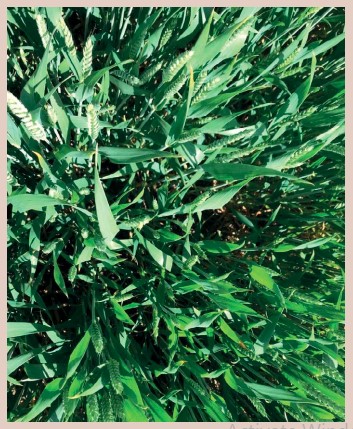
Spring Beans were drilled on the green and using the crimper roller that Trevor Tappin built for me. It worked very well as ever, with each roller being independent and able to follow the contours of the land, along with being able to set the pressure to suit the crop on the roll using air, I was able to achieve the perfect crimp! Cover crops were a little uneven here due to the very dry start they had last year, which meant I also needed a low dose of glyphosate to finish the crop off. Beans were drilled with a compost tea, from a 1:1 F/B compost made on farm in my new extractor/ brewer, which has worked fantastically well! I have been a little better off for rain this Spring, than I was last year (desert) and the whole farm looks very well at the time of writing (which has probably put the kiss of death on it!) But it really is nice to see the whole farm functioning well and work coming together. For anybody just starting off on the journey, firstly, well done for starting and secondly, always remember where you are heading and what you want to achieve; as it doesn’t always go as planned and can be challenging, but isn’t that the roller coaster of life? You must have the dips to appreciate the highs and one would get bored if it was continuing highs!
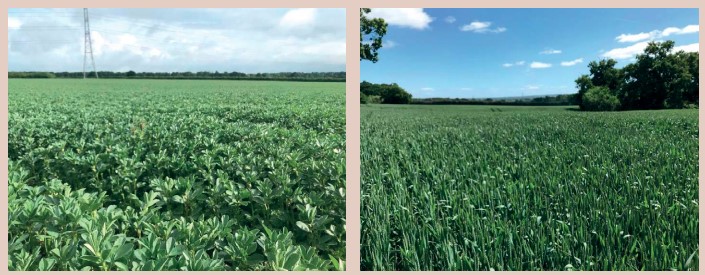
I have also been kept busy this Spring with my colleagues at The Green Farm Collective, holding our first conference #GFC22 on the 25th May, along with Trinity AgTech and our sponsors – Edaphos, Oakbank Game and Conservation, Severn Trent Water, Soil First Farming, Kings Crops, Indigro. A good day was had by all. Carbon and biodiversity are going to play a big part of our incomings going forward and will become the norm for future generations of farmers.
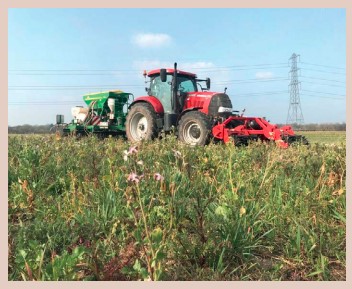
Trinity AgTech launched their grassland module for permanent grassland and Severn Trent Water launched some of their new catchment area schemes, which were welcomed by those in the catchment areas.
Hope to see you at Groundswell and I wish you all a successful harvest.
-

Drill Manufacturers In Focus…
SOLAR-POWERED SEED-N-WEED ROBOT WITH SIMPLICITY ON ITS SIDE

A fully autonomous, solar-powered robot capable of precision drilling and weeding has joined the OPICO line up and will be on display at Groundswell this June.
Offering pesticide-free weed control with zero fuel and minimal labour bills, the FarmDroid is the brainchild of two Danish farmers and takes a really simple approach to how it works. The FarmDroid uses ultra-accurate GPS to record exactly where it places each seed. Then on each subsequent weeding pass it has no need to identify what’s a weed and what’s not – it simply knows where the crop plants should be and works around them, hoes shares running between each row and blades slicing off anything between each crop plant, in the row. This approach means that unlike other similar machines, it doesn’t need to employ banks of high-definition cameras and complex computers to identify and target weeds. It also means the machine can start the weeding process before the crop has emerged because camera recognition is not required.
Its simplicity is just one of a number of features that set the machine apart from anything else on the market. Being solar-powered, FarmDroid owners don’t have any fuel bills for the machine. Not only does this have a clear impact on the bottom line with today’s increasingly volatile energy markets, it’s also environmentally friendly. In a future where food retailers are progressively looking to be perceived as ‘green’ with carbon audits becoming more and more common, the FarmDroid can help provide one step towards energy self-sufficiency (and herbicide-free crop production).
With in-row and inter-row action it eliminates weeds both between the rows and between the crop plants. Capable of working right to up within 5mm of each seedling between the rows and 20mm in the row, the FarmDroid’s shares mean it does the complete job so there is no need for handrogueing problem weeds like fat-hen (saving c.£250/ha). Weighing just under 1,000kg, FarmDroid has the lightest footprint possible – good for soil health and the bottom line – headlands aren’t run down with the result that yields are maintained across the entire cropped area. In fact, organic growers across northern Europe – and in the UK – have seen some fairly dramatic results where they’re using the FarmDroid. They’re reporting increases in sugar beet yields of 40-60% over tractor-hoed crops and are putting this down to the combination of precise seed placement and intra-row weed control making for uniform crop development.
Combined with the savings in herbicides, fuel, labour and machinery costs (depreciation, maintenance, tyres, capital tie-up, etc…) – the financial argument for FarmDroid is a strong one, especially as the purchase price and ongoing running costs are a fraction of those associated with the traditional machinery used to do the job. The current sixrow FarmDroid FD20 retails at £59,500 with an additional £4,243 required for an RTK base station. Grant funding is likely to be available to assist with the purchase of this innovative seeding and weeding machine. “We believe robotics will form the backbone of the next major step in technological development for agriculture,” explains OPICO managing director James Woolway.
“FarmDroid has come up with a unique solution that is suited to large and small-scale farming systems. OPICO’s distribution network, parts and technical teams are more than capable of backing the product up so it’s a great fit.
“While it’s early days, we’re coming to the UK market with a product that is tried and tested. The timing couldn’t be better with rising energy costs, labour issues and environmental factors at the forefront of UK farmers’ minds. FarmDroid ticks so many boxes in all these respects.”

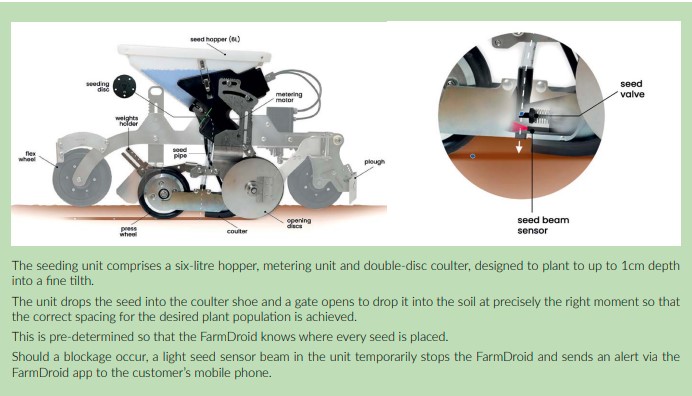
-
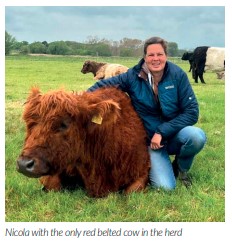
Demand For 100% Pasture-Fed Beef Soars As Consumers Look For HIGH QUALITY BEEF
Pasture for Life continues to attract new farmer members as interest from consumers looking for high nature-value,
nutrient-dense meat and dairy grows every day. Here two farmers explain how being Pasture for Life certified has
contributed to their success. Sara Gregson reportsNicola Chapman, Carr Farm, Suffolk
Twenty Belted Galloway cows with their calves, all with their distinct, thick white band around the centre of their bodies, graze peacefully on the marshes at the bottom of Nicola and David Chapman’s 40-hectare farm, at Burgh St Peter on the Suffolk/Norfolk border.

The Chapmans arrived at Carr Farm in 2011, from a smallholding in Diss. Originally, the land had an agricultural tenant, but has now been taken back in hand. Half comprises drained marshes of the River Waveney and the rest is higher land of light sandy, gravel soils. “David and I were both working full time to start – David with the NHS in Norwich and me as a surveyor,” Nicola explains. “I gave up completely two years ago and David is now down to working three days a week, so we are gradually finding more time to do the things we want to on the farm.”
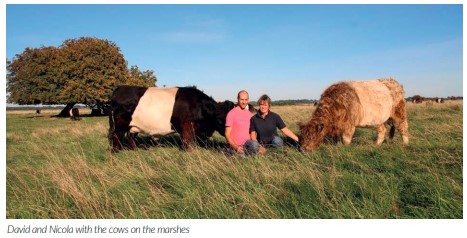
The Chapmans carry out low impact farming, encouraging all elements of nature and wildlife to flourish alongside the production of prime beef. The pedigree Waveney Herd graze extensively at home and on a further 49 hectares across several parcels of land, mainly belonging to the Suffolk Wildlife Trust, but also some reserves in private hands.
“I always knew I wanted to have cattle,” says Nicola. “After we bought the farm, we reverted the arable fields into grass and then had to decide which breed of cattle we wanted. “With no barn then for winter accommodation, we were looking for hardy, native cattle that were not too big but that produced fine meat to eat. Belted Galloways fitted the bill perfectly.
The Chapmans sourced their first five pedigree heifers with help from the Belted Galloway Pedigree Cattle Society in 2014. Now there are 80 animals in total, including the cows and calves, yearlings, breeding youngstock and finishing animals.
“The steers mature very slowly, eating nothing but the grasses and plants that grow out on the marshes. Nothing leaves here under 30 months of age and it is this that gives the meat its incredible texture and flavour,” says Nicola.
The cows overwinter on the freedraining sandy land behind the farm house and are supplemented with large hay bales made from the marshes the previous summer. In April the grazing agreements start and the yearlings go to the furthest sites, including Carlton and Oulton Marshes. The cows mainly calve from early April for two months and calve easily and without assistance. A few of the older mothers are now more than ten years old.
Pasture for Life
“We joined Pasture for Life straight away and became certified,” explains Nicola. “This means we can use the Pasture for Life logo on our beef packs which is the only 100% grass-fed guarantee. “A third of our customers buy our meat for health reasons because they cannot eat meat from animals that have been fed grain or soya. Another third are local customers who buy because they love to see the Belties grazing on the marshes – there is a real connection.
“Direct selling is hard work and I spend a lot of time being a retailer and promoting our beef on social media. We have built up a loyal list of customers who we email when a beast is ready. “But there are signs of more interest coming now from butchers and restaurants, as the benefits of farming in a more regenerative way become more widely recognised.”
Anna Blumfield, Deersbrook Farm, Essex
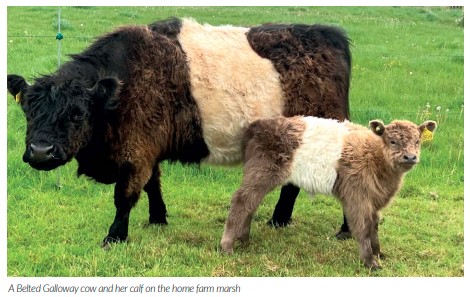
Anna Blumfield and her husband Phil started a grass-fed only herd of Sussex cattle alongside her parents intensive cattle rearing and fattening unit, near Braintree in Essex in 2015. She always knew she wanted to sell her meat direct to the public and setting up the new herd was the way she saw to do this.
“After lots of research we knew we wanted to go down the 100% Pasture for Life way of farming and we knew the Sussex breed would absolutely thrive on this type of system,” Anna explains.
A total of 190 head of cattle – including 115 suckler cows, now graze 41 hectares of grassland at the home farm, as well as a further 278 rented hectares on grazing agreements, including Natural England heritage sites and some around some MOD airbases.
“Throughout their lifetime our cattle graze different biodiverse pastures filled with clovers and herbs,” says Anna. “They also browse the hedgerows and trees which means they can access all the nutrients they need.
The cattle spend spring, summer and autumn grazing and come into strawbedded barns in November and fed just hay, silage and minerals. Muck from the winter barns is composted and applied back to the home fields.
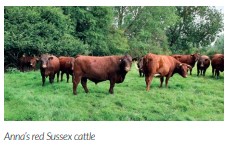
Most of Anna’s grass-fed cattle finish at 26 to 29 months of age at 300 to 350kg deadweight and grade at an average conformation score of R4L. Anna started selling her meat at farmers’ markets and from a small shop on the farmyard at home. In 2018 she opened a new butchery and shop, giving her more control over how individual carcasses were broken down and presented.
“We’ve built a really solid customer base, and are now selling a full carcase every week,” says Anna. “Customers range from locals who pick up their regular staples, to those who come from further away, many aware of the nutritional advantages of 100% grassfed beef and buy all kinds of cuts to fill their freezers.”
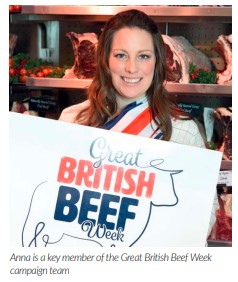
Anna was one of the first beef farmers to become Pasture for Life certified in the country.
“Being Pasture for Life certified is fundamental to our business because it encompasses everything we believe in – the ethos of regenerative farming, working with the ruminant’s natural digestive system, and farming to benefit the environment, wildlife and water systems as well,” says Anna. “It really is all encompassing to what we believe farming should be.
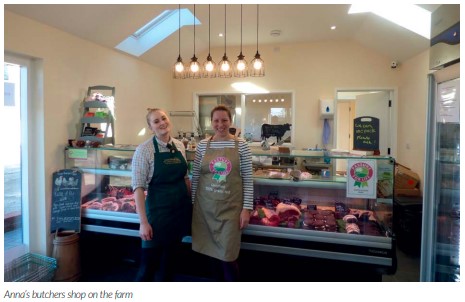
“I’ve been lucky enough to attend lots of Pasture for Life tasting events supplying cuts of our beef and talking about how we look after the animals to consumers. I have also taken every opportunity to promote the principles of 100% grass-fed beef production on national and local radio and national TV, including Saturday Kitchen and Newsnight.
“Pasture for Life has really supported us over the years, and this, with the certification has given our customers trust in the product they are buying from us. It’s been a fantastic journey so far and long may it continue!”

Pasture for Life launches new visual identity
The Pasture-Fed Livestock Association has announced it is to be known as ‘Pasture for Life’ from now on and has launched a new logo and visual identity. The past two years has seen growing numbers of consumers looking for livestock products that come with high environmental, ethical and health credentials. This has prompted the organisation to refresh the way it communicates to drive greater awareness of high nature-value farming. The move, which coincides with Pasture for Life’s 11th birthday, marks a significant moment for the organisation, which has grown from a few farmers back in 2011, to a diverse group of farmers, butchers, dairies, artisan food producers, chefs, nutritionists, academics, students, storytellers and many more. Membership now stands at more than 800.
“We have refreshed our visual identity and our core messages to better reflect the benefits of 100% pasture-fed farming,” says Pasture for Life Executive Director Jimmy Woodrow. “We hope this will help our farmers communicate the benefits of the way they farm and help shoppers find and understand the health, welfare and environmental advantages of buying Pasture for Life certified food and fibre.”
In addition to the new visual identity, Pasture for Life also launched a short film to mark its first ten years, which can be viewed on the Pasture for Life YouTube channel.
-

World Congress Of Soil Science 2022
31ST JULY TO 5TH AUGUST 2022
The World Congress of Soil Science 2022 (WCSS 22) is a leading international soil science conference, held every four
years in different countries and attended by over 3,000 soil scientists from around the globe. The next Congress is
being organised by the British Society of Soil Science on behalf of the International Union of Soil Sciences.The Congress theme, ‘Soil Science – crossing boundaries, changing society’ will focus on the link between soil and
society, with sessions covering soil systems, soil processes, soil management and how we interact with and use soils
around the world. There will be opportunities for specialist workshops and discussion sessions across a wide range of
soil disciplines. The core programme is supported by tours and a cultural and arts programme for delegates and the
wider public to explore our diverse environment and culture.Where & when is it?
The Congress will take place at the award winning and world-class Scottish Event Campus, a riverside venue minutes from central Glasgow in Scotland, UK. The Congress will take place between 31 July and 5 August 2022, flanked by an exciting menu of soil science activities such as the soil tours, soil judging programme and outreach activities under the banner of Our Living Soil.
Who should attend?
The congress is open to anyone who has an interest in the sustainable use of soils, particularly research scientists, regulators and NGOs. There will be a specific policymakers’ programme on Tuesday 2 August 2022 to discuss how scientific research can inform environmental policy.
Speakers
The exciting programme includes the full list of plenary, divisional and interdivisional sessions and the agreed keynote and oral presenters for all sessions. Plenary speakers at the event will include Dr Ranveer Chandra, CTO AgriFood, Microsoft, USA; Prof. Suzi Huff Theodoro, Professor of Soil Geology, Pesquisadora Universidade de Brasilia; Prof Ismahane Elouafi, Chief Scientist, UN FAO and Dr Debra Roberts, CoChair of Working Group II of the IPCC, Durban, South Africa.
If you haven’t already booked, don’t miss out on the opportunity to attend the major soil science conference of the last four years. To book your full congress ticket or one-day delegate pass, please visit www.22wcss.org.
Why should i attend?
At a time of global concern for our planet and its growing population, managing our soils sustainably has never been as important. 90% of our food comes from soil, as does all of our timber and other fibre. Soil, and the ecosystems it supports, have a huge role in mitigating against climate change, is a vast reservoir of biodiversity, plays a significant role in flood management and contains key evidence of past civilisations. Our understanding of the importance of these functions is developing rapidly and the Congress provides the ideal setting to discover the international state of the art in these critical global issues and an opportunity to connect across all who work with and rely on soils.
#GROUNDED
SOIL RESTORATION

Our supporters Lizzie Daly and Riverford Organics recognise the need for effective action and that the protection and restoration of soils must be a global priority. At a policy level, the British Society of Soil Science (BSSS) supports the Global Soil Partnership, led by the UN and we will be leading the call for collective change at COP 26 and the World Congress of Soil Science 2022. It is estimated that there are 1,500 gigatonnes of carbon in the world’s soil; three times more than in all vegetation and forests. Deforestation, global warming and poor farming practices can lead to the release of soil carbon into the atmosphere, and in turn speed up the climate warming process.

Our Science Note: Soil Carbon, sets out why soil carbon is so important and outlines our recommendations for governments.
Healthy soil supports biodiversity: biodiverse soils can host millions of organisms in each teaspoon. Sustaining life in soil is essential to ensure soil health, which supports our ability to grow food and farm effectively. When managed well, soil can store significant amounts of rainfall, preventing flooding and stop soil washing away, which can affect the health and safety of communities.


-

Drill Manufacturers In Focus…
STRIPPING BACK ESTABLISHMENT COSTS

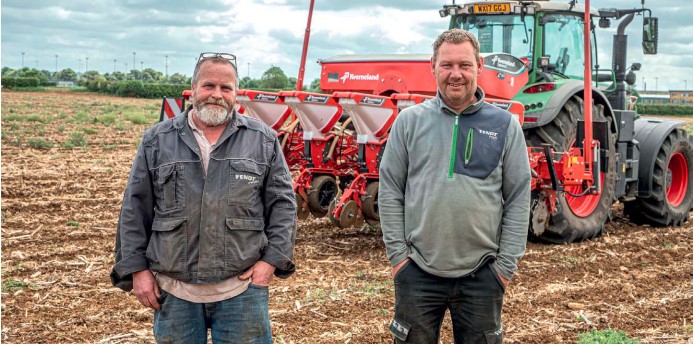
Looking to reduce the cost of producing grain maize, Andy Longman of Snagg Farm near Shepton Mallet, Somerset, has opted for a Kultistrip to develop strip tillage practices for the high value forage crop.
It followed a demonstration in 2021, where a six-row Kultistrip was put to work, preparing ground ahead of a contractor’s eightrow maize drill. “It was very much trial and error, but we liked what we saw,” explains Andy, pictured left. “So we bought the Kultistrip and a six-row Optima V from C&O Tractors, to precisely match-up with the cultivated strips. This season’s crop has gone in extremely well, saving time, fuel and establishment cost.” He says that of last year’s crop, those fields that were striptilled yielded 0.7t/acre more than the conventionally grown crop. “We weigh every load that comes off the combine,” he says. “I’m sure the yield difference came from the Kultistrip keeping moisture in the seedbed, compared to higher moisture loss from traditional seedbed preparation.” He says that weed incidence was reduced and has eliminated the need for a pre-emergence spray, enabling any weeds to be knocked out with a post-emergence application. “We’ll still need to plough periodically, but rotationally rather than as an essential part of maize establishment,” says Andy.
“This way, we can make the most of soil biology and microorganisms.” He says that taking control of the strip-tillage and drilling processes has created better timeliness, and the opportunity to experiment with pre-drilling cultivations. With the Kultistrip, the surface is stripped clean ahead of soil being loosened across a narrow 150mm strip, courtesy of front cutting discs, a loosening tine and side discs, before being crumbled and firmed by Farmflex rubber press wheels. “We’ve done a lot more preparation for this year’s crop by switching to two passes,” he says. “The first was at 6in to set the ground up, then a deeper pass followed a few weeks later at 9in, ahead of drilling.” “If we can get a front tank sorted, we’ll put fertiliser into the strips instead of broadcasting on top of the seedbed, to increase plant uptake,” he adds. “We’re looking for 1,000 tonnes of grain off 180 acres, using three varieties.”
Operator Chris Keen (pictured right) is impressed with the process.
“The Kultistrip is an impressive piece of kit, and then the Optima V just raises the bar another notch,” he says. “Seed placement accuracy – both depth and down-the-row-spacing – is amazing. And with RTK guidance, we can match up the six rows perfectly.”
Chris says the range of adjustment on both the Kultistrip and Optima V provide enough scope for the soil types and field conditions encountered.
“Sowing depth is as good as guaranteed, no matter what the conditions,” he says. “And without overlaps from electric drive and section control, we’re using less seed. Seed counts are typically 40,000 per acre, and we’re looking to cut back to around 37,000.” Chris adds that the Optima V’s hydraulically telescoping frame affords easy road transport, and total control of row widths from 40-85cm, handy when precision planting other seed types. “We bought beet discs too, which brings additional versatility from investing in the drill,” he adds.
Andy Longman is pleased with the changes made to maize establishment at Snagg Farm.

“We’ve just sown 65 acres of maize with one operator and tractor, in just three days and that includes the time spent making two passes with the Kultistrip,” he says. “Our Fendt 724 is burning just five litres/acre with the Kultistrip, and 2-3 litres/ acre when drilling, which means our diesel use is close to 25% of what we’d normally use for seedbed production.” He says the key to its success lies in effective cultivation of the area to be occupied by the rows of maize. “Why should we continue to move all the soil when maize is grown in 75cm row spacings?” he asks. “This is where strip tillage makes so much more sense. The untouched ground helps to carry the weight of machinery, which limits compaction. And not moving so much soil helps to discourage weed germination.” “With an increase in the cost of diesel this year, and a higher grain price, the Kultistrip should pay for itself in little over 200 acres,” he adds.
Come and see this combination in action at Groundswell, on 22 and 23 June, at Lannock Manor Farm, Hertfordshire.